Since the Clean Car Programme was launched, the MG ZS EV seems to have popped up like a meerkat. With a distinctive grille, it’s obvious if one is driving towards you, and that happens often.
But other players have since come to the market and mainly for MG, that threat was another Chinese brand, BYD. With similar – but slightly more expensive – pricing and blade batteries, BYD is starting to steal sales from MG.
For 2022, MG has refreshed their ZS EV with a slightly bigger battery (now 50.3kWh), a new front design, NVH improvements and carryover pricing – so no increase in cost.
We last reviewed the MG ZS EV in 2021 and found it to be good value, but a little lacking in some areas. That was to be expected for a model new out of the blocks. But can the changes that MG has made enable it to fend off opposition from BYD? After going to the launch, we grabbed a new ZS EV and did the 652Km drive home in it, then shared it with the team for a few weeks.
Want to know what the 2022 MG ZS EV Essence is really like? You’ve come to the right place.
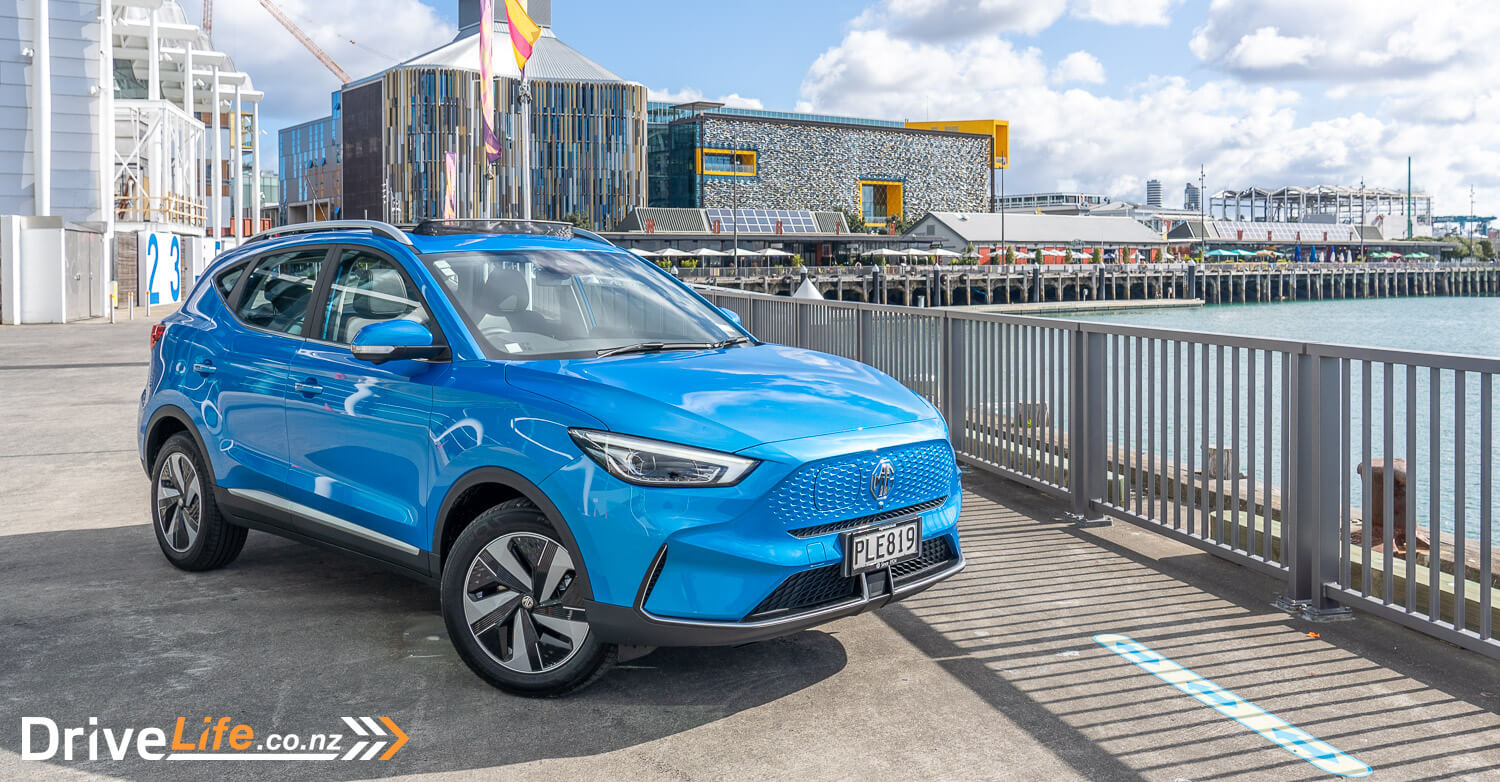
What We Like and Dislike About The 2022 MG ZS EV Essence
| What we like | What we don’t like |
| A relatively refined drive Price Equipment levels NVH improvements USB port arrangements App functionality Interior materials and quality Ride quality | App functionality No tilt steering Tyre noise Aggressive lane-keep assist |
What’s In The 2022 MG ZS EV Range?
There are two models in the 2022 MG ZS EV range and both are eligible for the full $8,625 Clean Car Programme rebate.
Without the rebate, the price of the Excite is $49,490 and the Essence is $53,490.
MG has “driveaway” pricing of $49,990 for the Excite and $53,990 for the Essence so this includes on-road costs.
Both are identical in drivetrain and battery; you get a 130kW electric motor to drive the car, and that outputs 280Nm of torque. It’s front-wheel drive only.
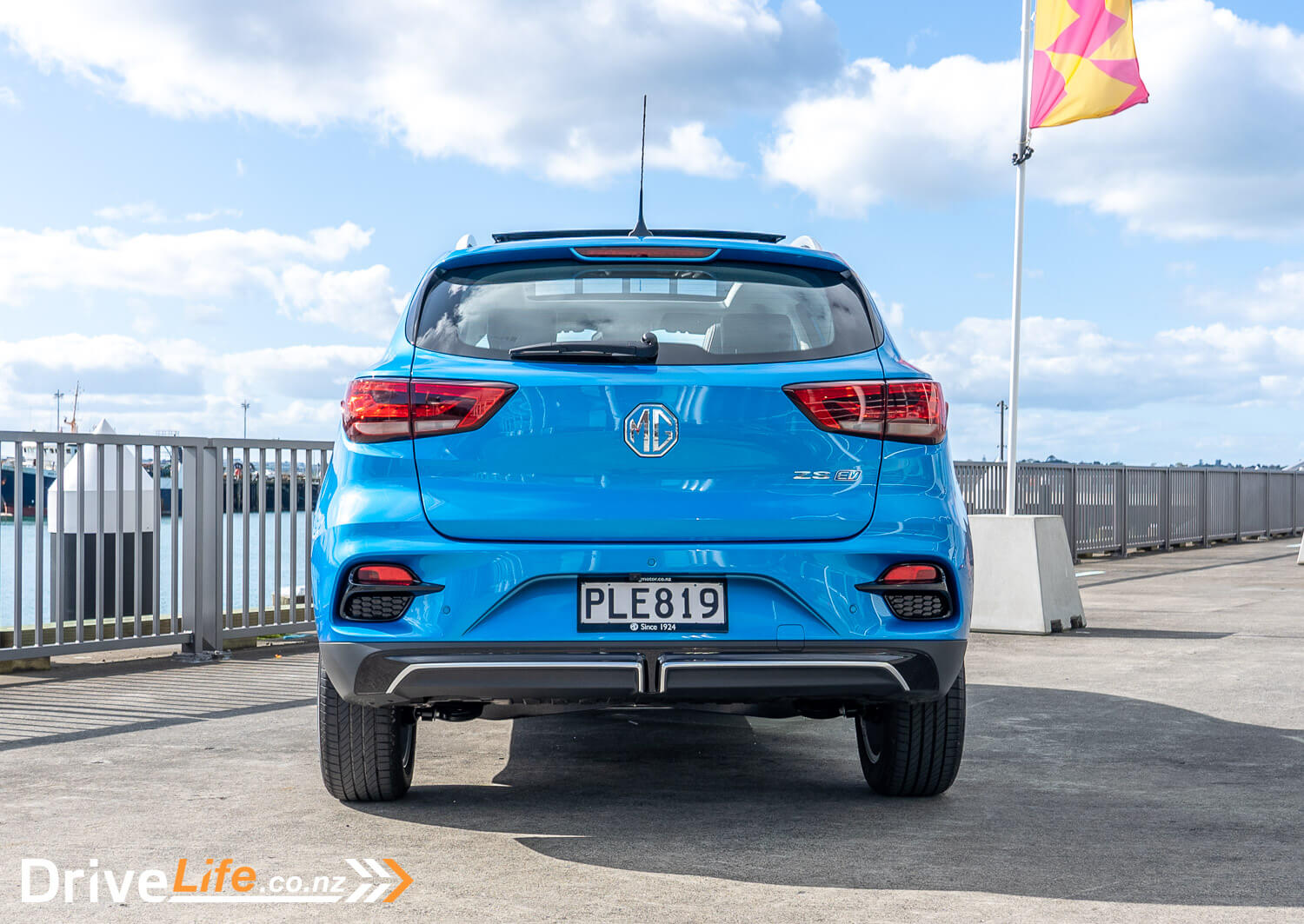
2022 MG ZS EV Standard Equipment Highlights
- 3 Driving Modes (Eco, Normal, Sport)
- 3 Regenerative Braking Modes (1,2,3)
- Push Button Start
- i-SMART Connectivity
- Vehicle to Load Functionality
- 360 View Camera
- LED Daytime Running Lights
- Satellite Navigation
- Houndstooth Patterned Fabric Seats
- 10.1” Multi-function Colour Touch Screen
- Apple CarPlay & Android AUTO
- 17” Diamond Cut Alloy wheels
SAFETY
- 6 airbags
- ABS with Electronic Brake Force Distribution
- Emergency Brake Assist (EBA)
- Electronic Stability Program (ESP)
- Active Cornering Brake Control (CBC)
- Side impact absorbent door padding (front doors)
- Pretension and load limiting front seat belts
- Hill launch assist
- Rear seat child restraint anchorage points
- Electric rear door child safety locks
- Automatic door unlocking in accident
- Automatic activation of hazard lights under emergency braking
- Ultra-High tensile steel cage body
- Intrusion minimizing and collapsible steering column
SECURITY
- Rolling code transponder immobiliser
- Visible VIN
- Internally operated central locking
- Delayed automatic locking
- Automatic locking doors and boot (activated by vehicle moving)
- Key left in vehicle lock warning alarm
MG PILOT
- Adaptive Cruise Control
- Forward Collision Warning
- Automatic Emergency Braking
- Lane Keep Assist with Departure Warning
- Traffic Jam Assist
- Intelligent Cruise Assist
COMFORT AND CONVENIENCE
- Cruise control
- Speed sensitive power steering
- Remote control central locking
- Vehicle to load charging (V2L)
- 360 View Camera
- Electric windows with driver one touch
- Height adjustable steering wheel
- Push Button Start
IN-CAR ENTERTAINMENT AND COMMUNICATION
- 4 speaker audio
- 10” Multi-function colour touch screen
- Apple CarPlay & Android AUTO
- DAB+ FM radio
- Steering wheel audio controls
- Satellite Navigation
INSTRUMENTS
- Speedometer with digital odometer
- Power counter
- Trip computer
- Multi-function digital display in dashboard
- Direct Tyre Pressure Monitoring System
- ‘EPS’ Electronic Power Steering mode adjust
Upgrading to the Essence model adds:
- Front Seat Heating – Driver and Passenger
- Panoramic Glass Sunroof
- Rain Sensing Wipers
- Roof Rails
- Wireless Phone Charger
- Synthetic Leather Seats
- Blind Spot Detection
- Rear Cross Traffic Alert
- 6 speaker audio with 3D Sound Effect
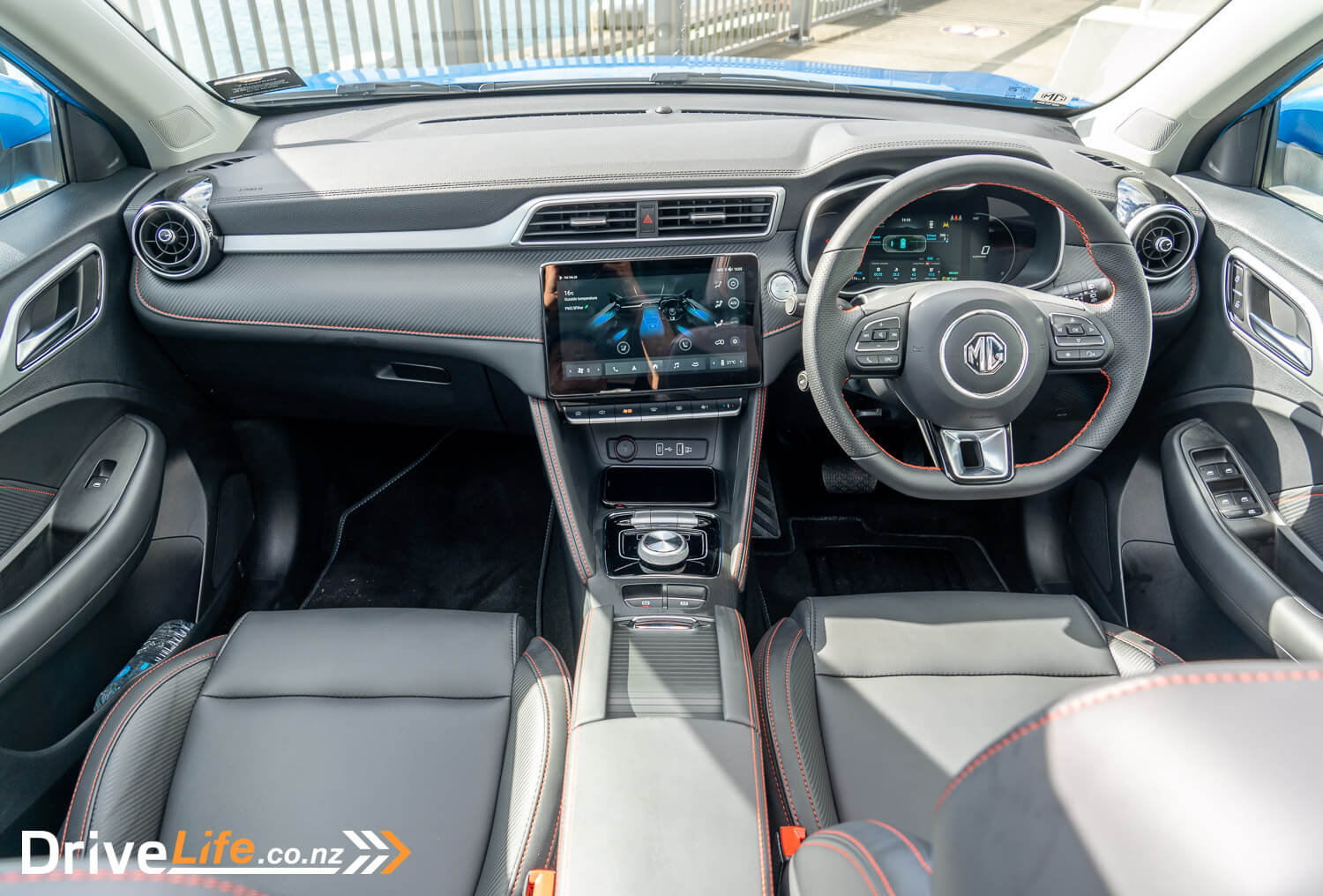
Our Review Vehicle’s Optional Equipment
- Carpet Mats at $125
Including the optional equipment, our review car’s retail (driveaway) price is $54,115.
There are 5 colours to choose from:
- Dover White
- Diamond Red
- Brighton Blue
- Pebble Black
- Sloane Silver
All are optional at no extra cost.
For a full list of specs and options available for the 2022 MG ZS EV Essence, head on over to the MG Motors New Zealand website.
How Does The 2022 MG ZS EV Essence Compare To Its Competition?
All prices below exclude the refund or additional cost of the New Zealand Clean Car Programme.
| Make/ Model | Battery Capacity kW-hr | Power/ Torque kW/Nm | 0-100km/h seconds | Range (WLTP) | Boot Space, litres | Price (excl CCP) |
| Mazda MX-30 EV | 35.5 | 107/271 | NA | 199 | 341 | $74,990 |
| Hyundai Kona EV | 39 | 100/395 | NA | 305 | 332 | $69,990 |
| BYD Atto3 Standard | 49.92 | 150/310 | 7.3 | 345 | 440 | $55,490 |
| MG ZS EV Essence | 50.3 | 130/280 | 8.2 | 320 | 359 | $53,990 |
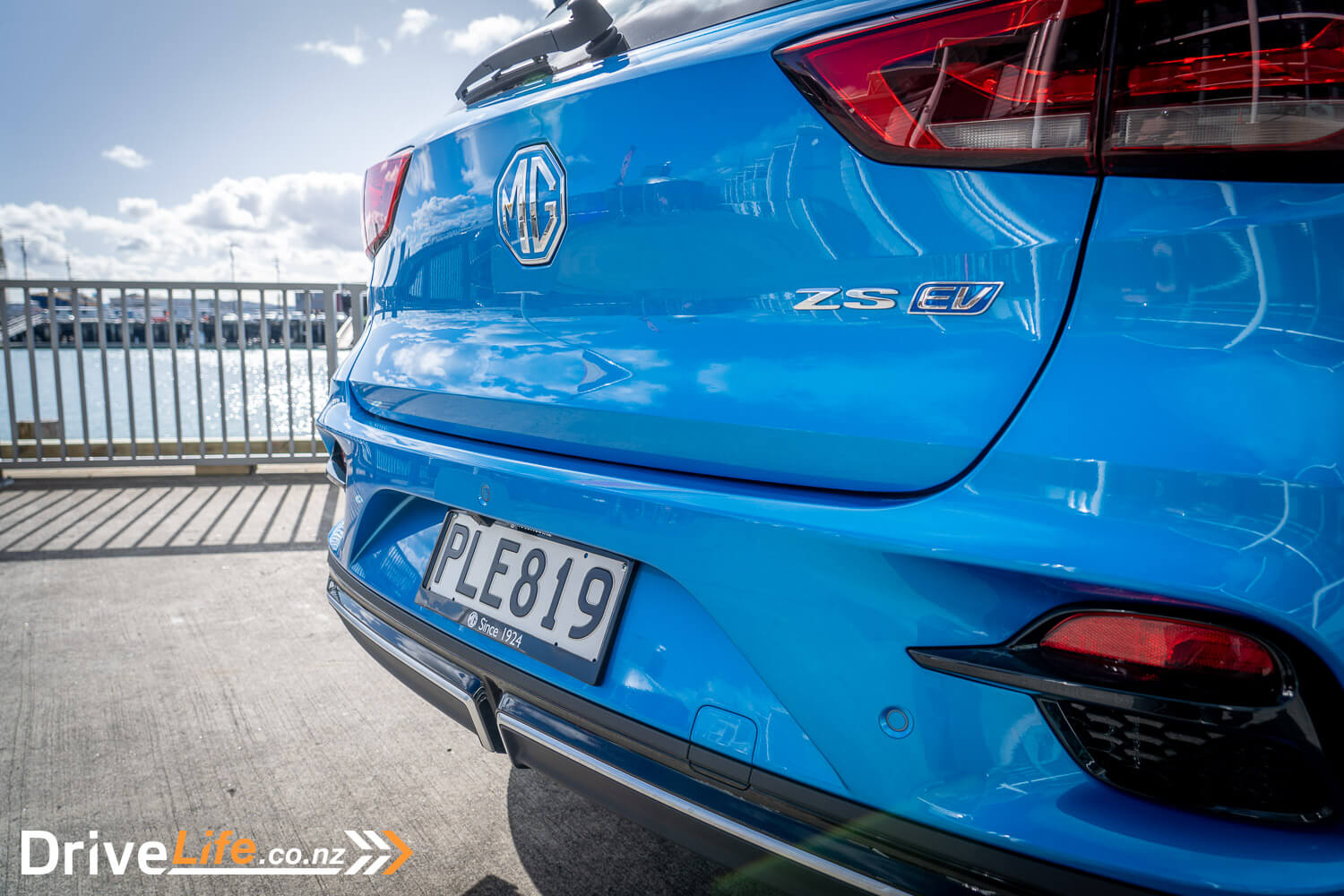
First Impressions Of The 2022 MG ZS EV Essence
It was almost a key feature of the outgoing MG ZS EV that it had the same grille as the petrol model. At DriveLife, we’re quite keen on that idea. Why make an EV look totally different to the petrol model if you want buyers to accept it as the new norm? Anyway, the new ZS EV has done away with the grille, and instead has a flat plastic panel that’s peppered with indents. I’ve never been a fan of this idea – the Kona EV leaps to mind – but it actually suits the ZS EV quite well. So, I’ve eaten my words.
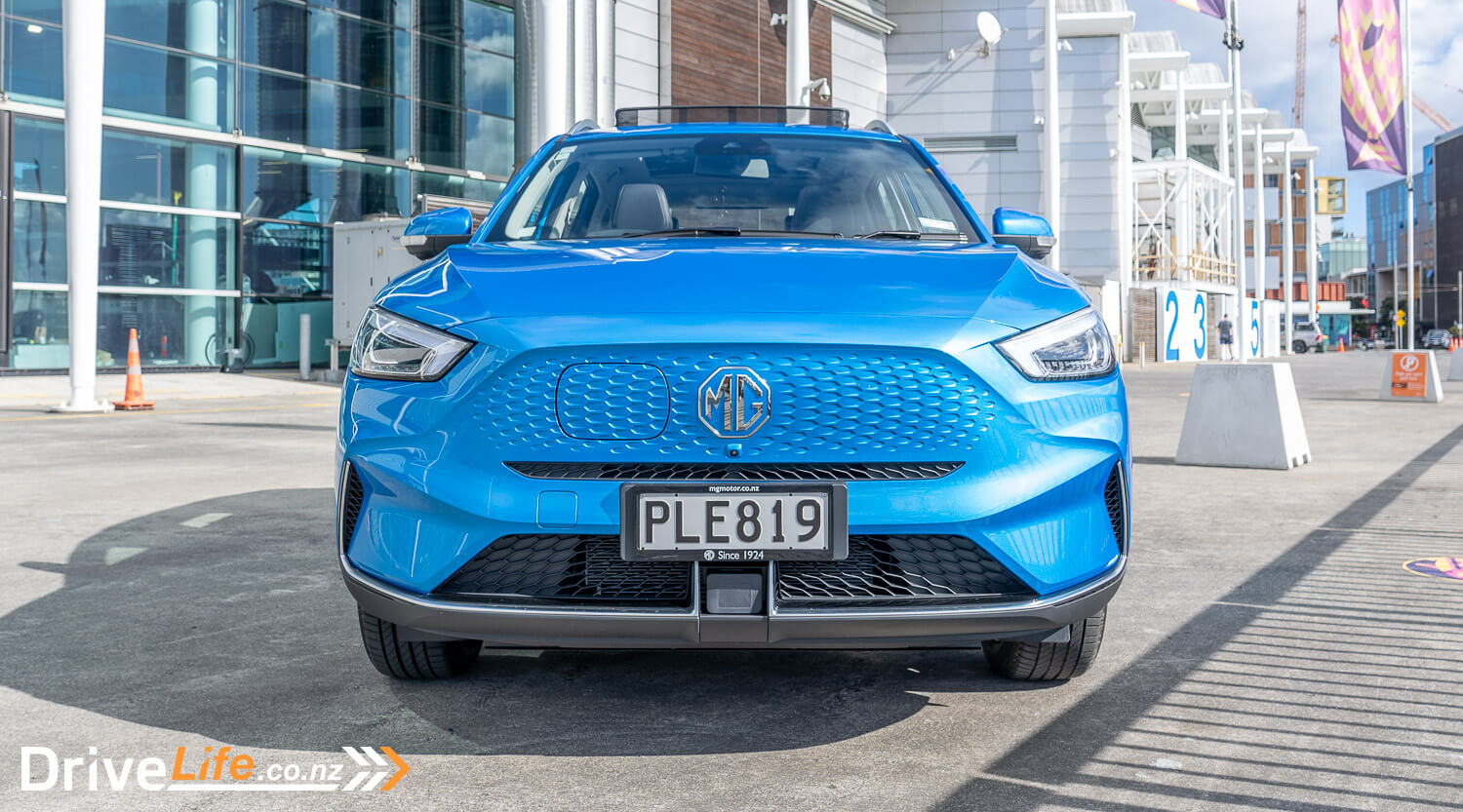
The headlights have gone LED, as have the tailights and both ends of the car look fresher, more modern, and they look good. This could also be down to the excellent Brighton Blue paint on our test car. It suited the shape of the car and it’s the colour I’d go for. Then again, while charging up in Waiouru I had someone asking me about the MG and when I asked her about the colour, she just about vomited. It’s a personal choice. Likely she’s one of those buyers that wants a boring grey car.
MG claims those LED headlights are based on the Silverstone Circuit…somehow. I can’t quite work out the connection between the famous racetrack and the headlights, but I’m told that’s what the design of the headlights works on.
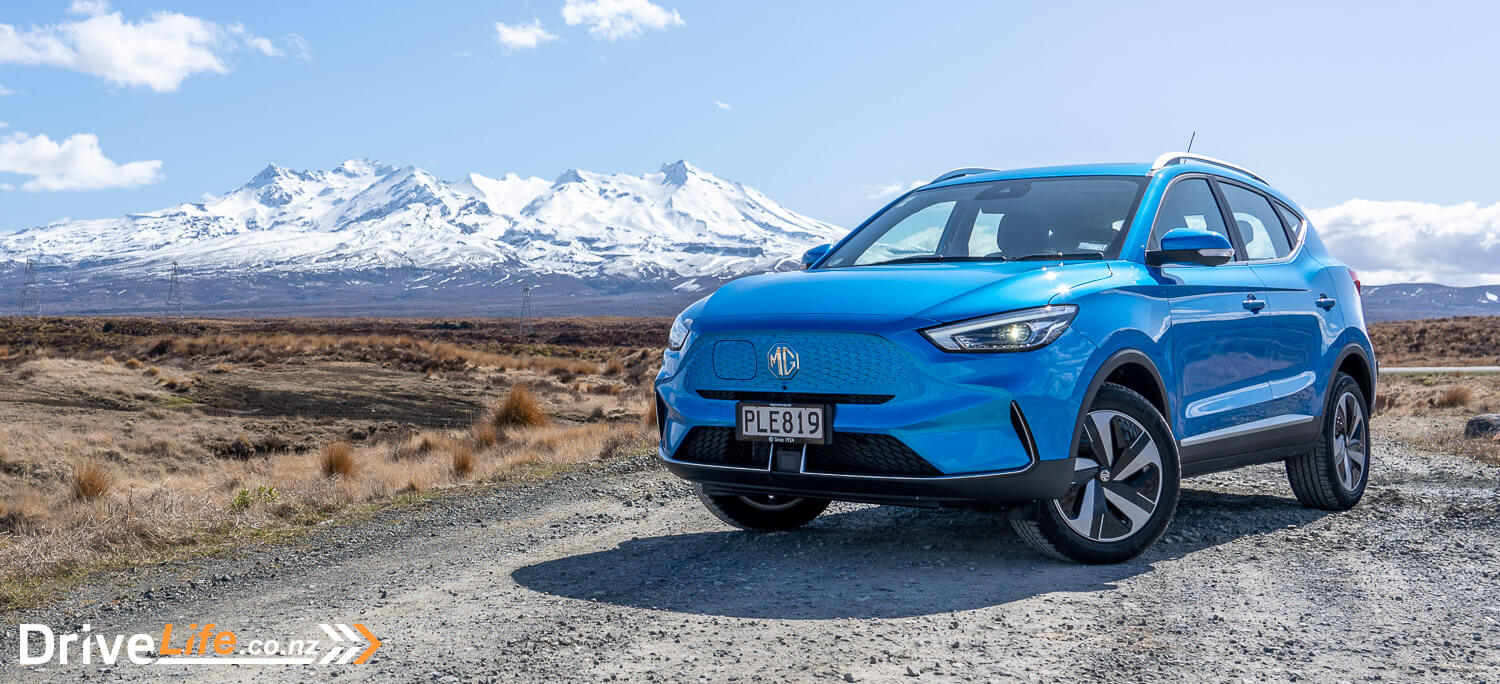
What’s The Interior Like In The 2022 MG ZS EV Essence?
While there haven’t been massive changes inside the new ZS EV, the new 10.1” centre touchscreen is a welcome improvement. It’s mostly integrated into the dashboard, and the clarity is very good. More on the screen in the Drive section of this review.
MG’s signature red stitching is all over the cabin, and it’s very well done. There is red stitching on the seats, doors, console, dash and steering wheel, and it looks excellent. It helps break up the black interior nicely, although it was great to see the car still has an ivory headliner and pillars, and this lightens up the interior a huge amount.
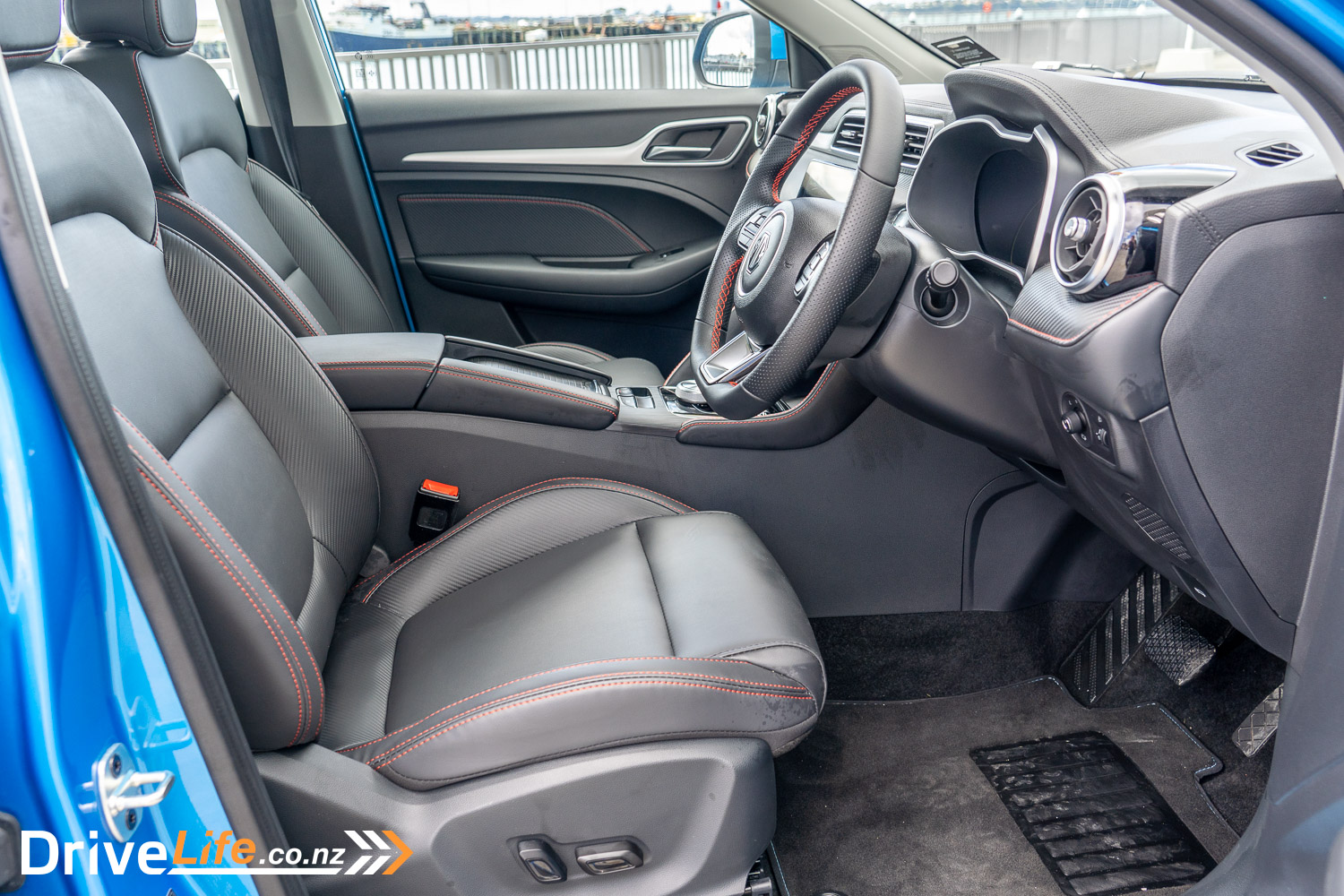
Since we’re testing the top-spec Essence, that means we get a panoramic sunroof. It’s a huge 1.3 metres long, and half of it is an electric tilt/slide. There’s also an electric fabric blind to help keep the sun out when needed. I can see many buyers going to the Essence model just for this feature.
There’s a nice mix of materials used in the cabin, and it certainly doesn’t feel cheap at all, with soft-touch materials used on the dash and doors. It all looks fairly classy, and it was also good to hear the doors close with a nice “thunk”. Chinese cars have come a long way from models like the Chery J11.
In saying that, the bullet air vents at each end of the dash flop around a bit. They still work just fine, but that’s the one place where the interior quality is let down.
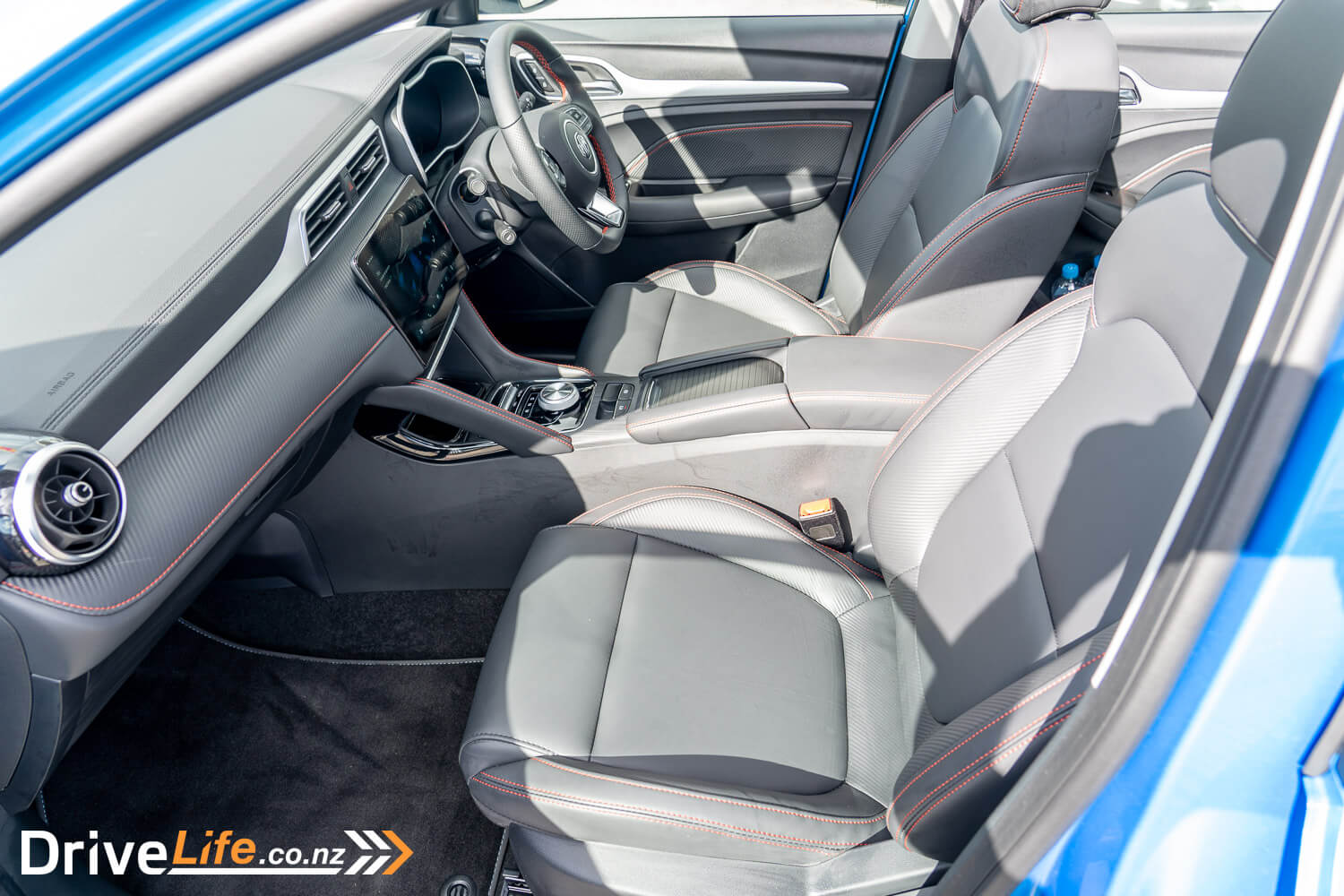
The glovebox is average in size for this model car, and contains the owner’s manual. You can also access the owner’s manual from the centre screen, but unfortunately, there’s no search or link function. I found this when I had to scroll down to page 212 of the manual. It took a while of finger flicking.
There’s a flat panel under the dash for wirelessly charging your phone, but that feature is only on the Essence. It’s a big, flat pad so I expect it’s big enough for all cellphones to sit comfortably on.
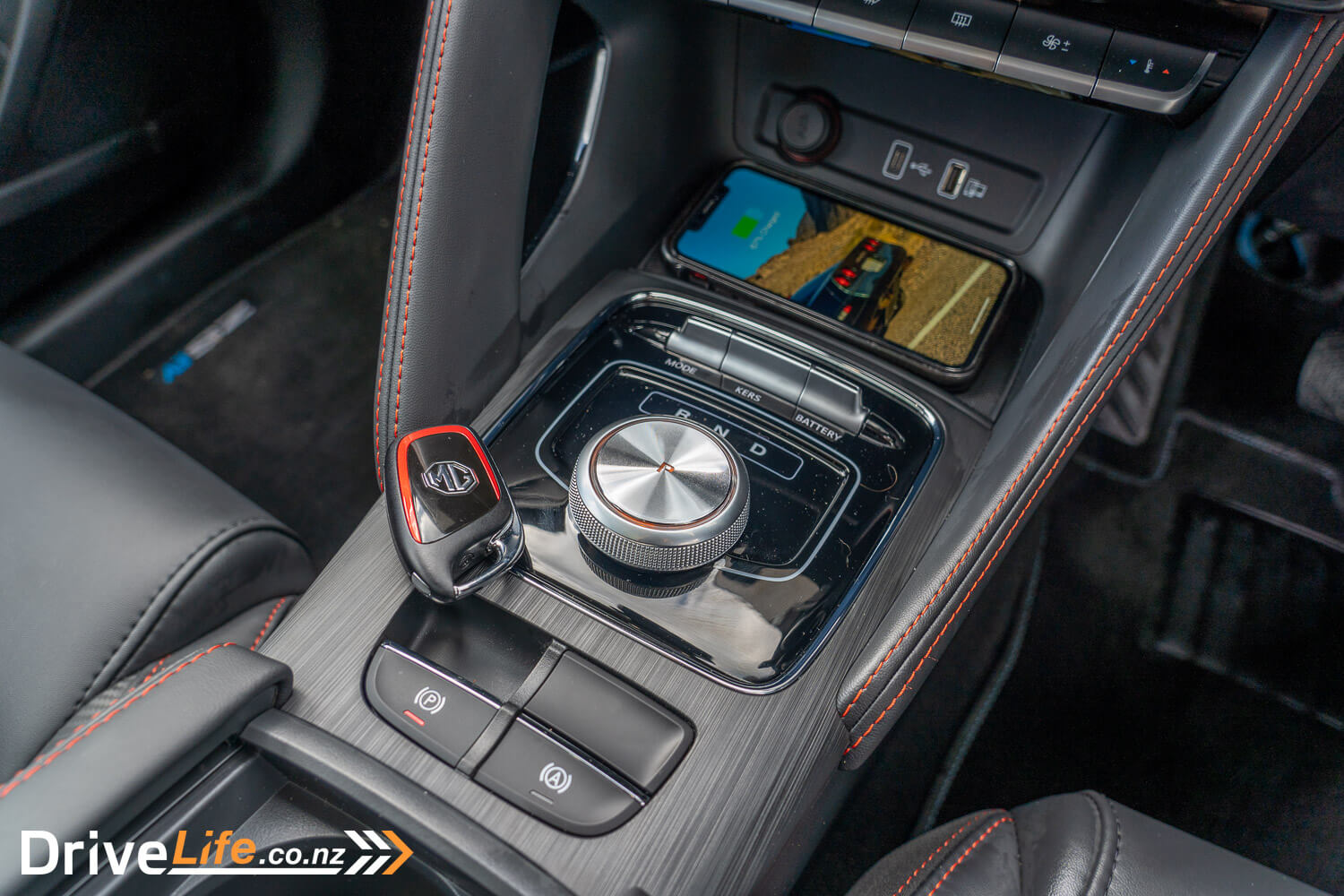
Above the Qi charge pad is a single 12-volt socket with two USB ports, one USB-A and one USB-C. Thank you, MG, for doing this. Rear seat passengers get the same USB port arrangement. Another nice thought by MG is the USB-A port up by the mirror, so you can plug in your dashcam without having to run cables. We’re starting to see this more and more and it’s a welcome addition to any car.
Rear legroom is still very good, and headroom is surprisingly good for a car with a sunroof. For 2022 rear seat passengers now get two air vents.
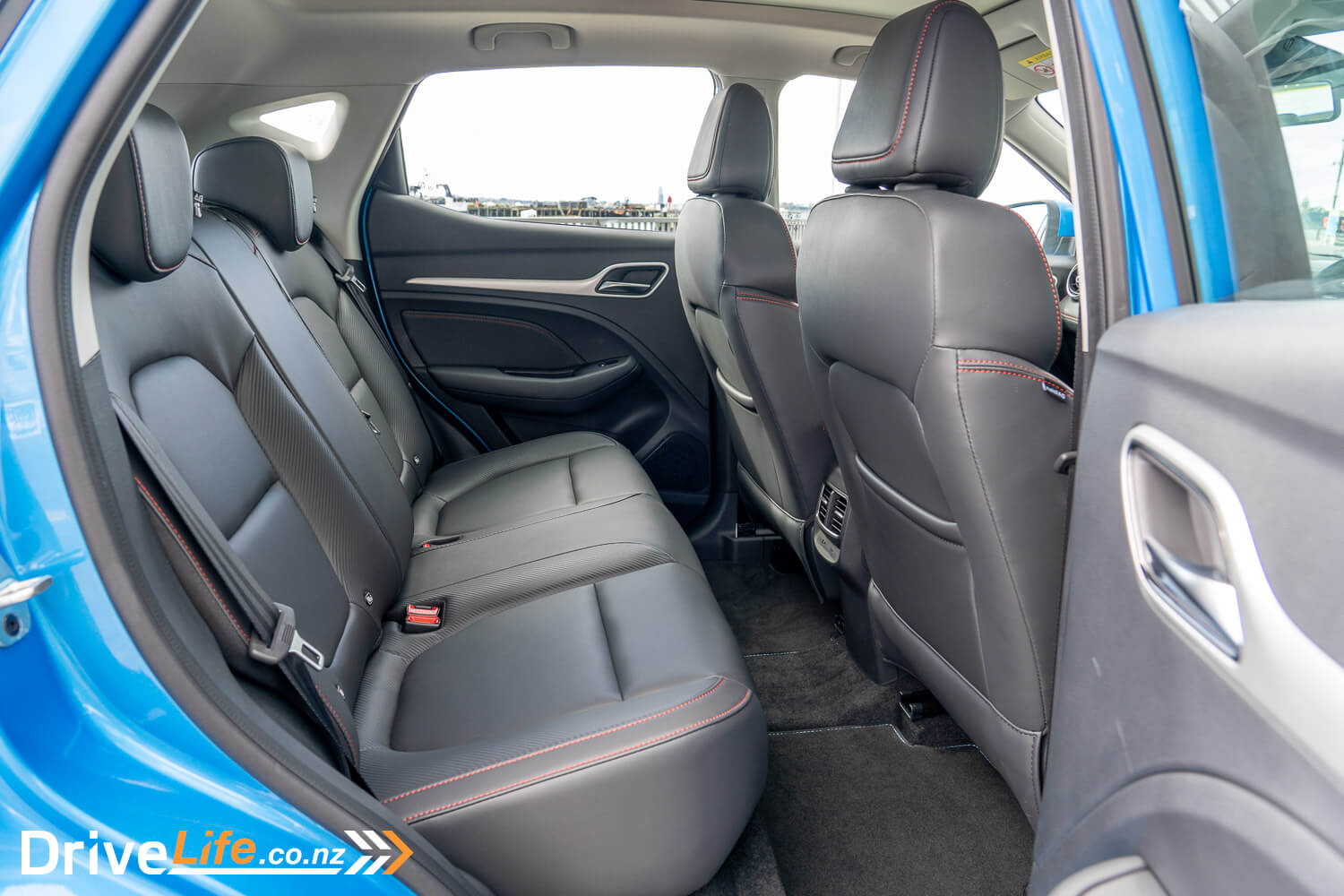
In the boot, it’s still a double-height arrangement, so you can drop the floor down to carry taller items. There’s no spare in there, just a 12-volt pump. Under the floor with a pump is another smaller storage area, it would be perfect for wet towels and togs after a day at the beach. There is another storage area on either side of the boot for loose items.
At 359 litres, the boot is very reasonably sized and extends to 1,187 litres with the seats down.
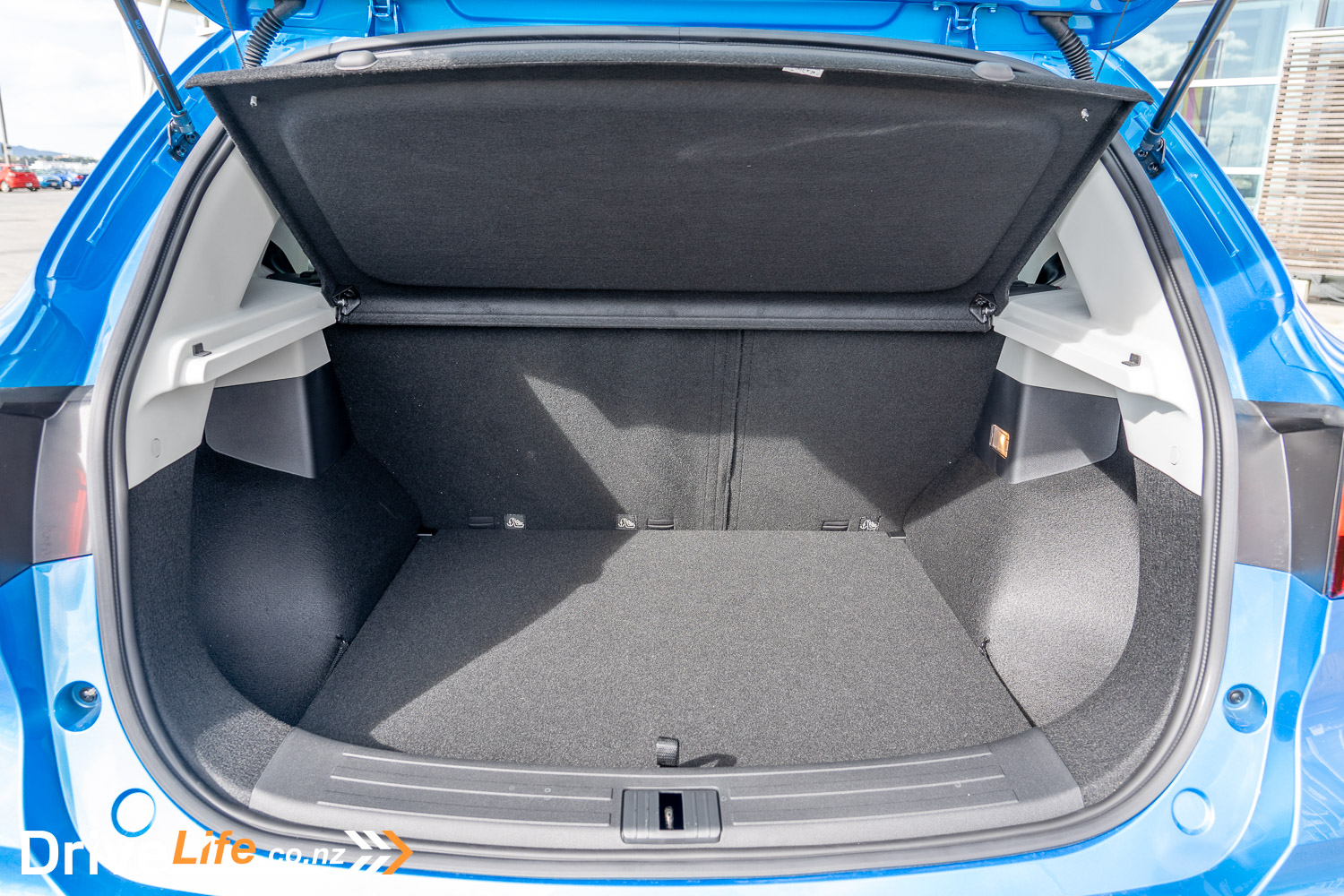
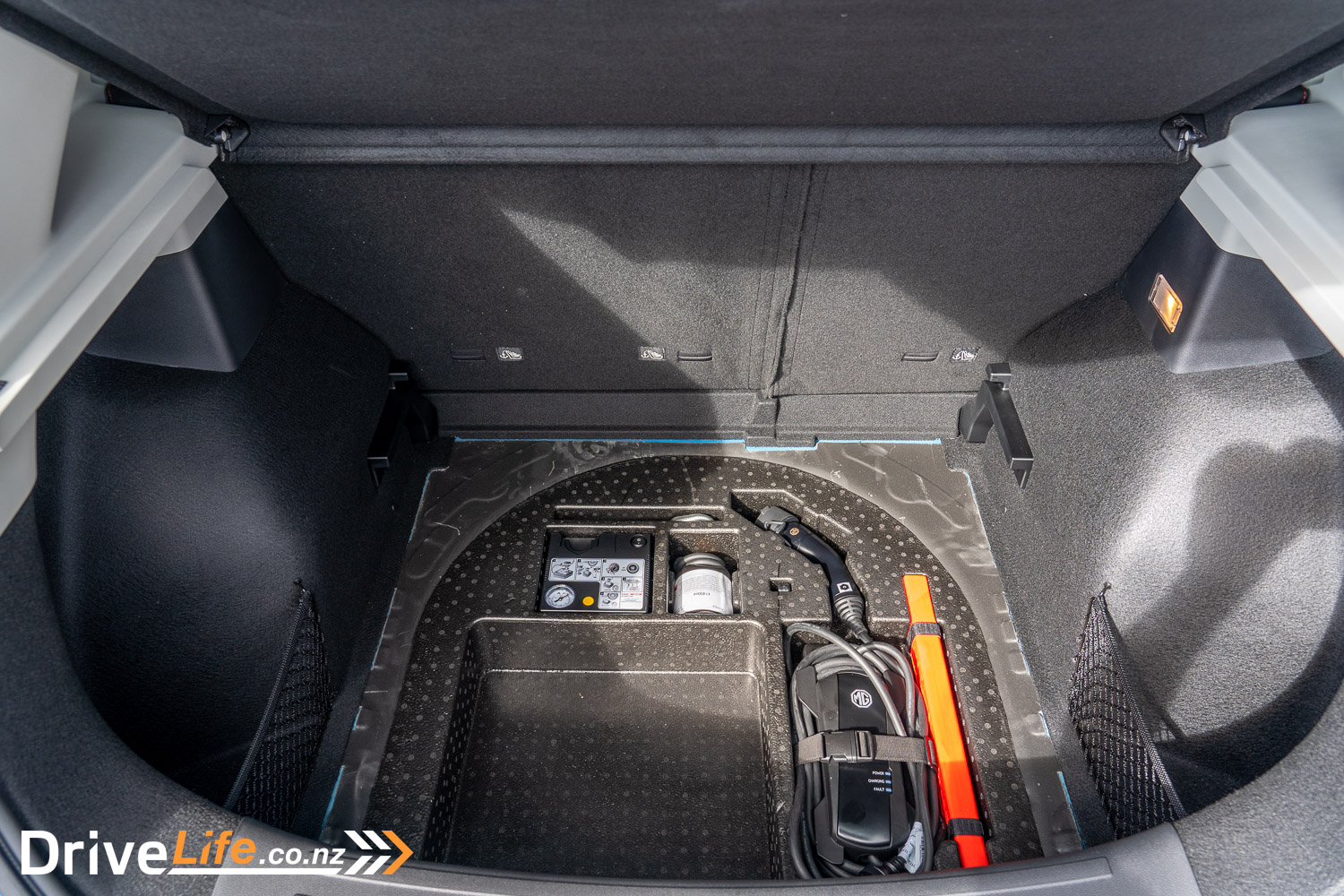
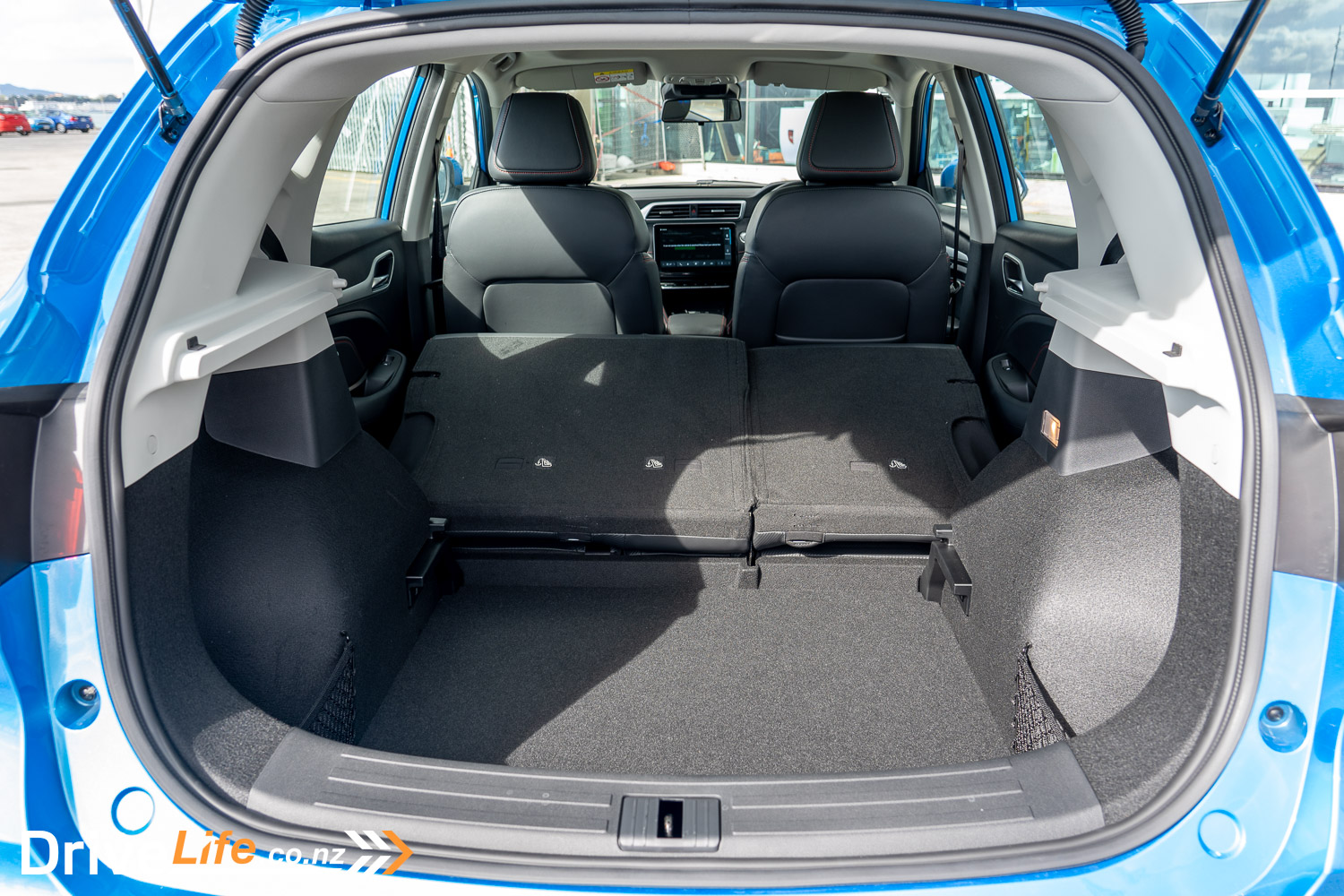
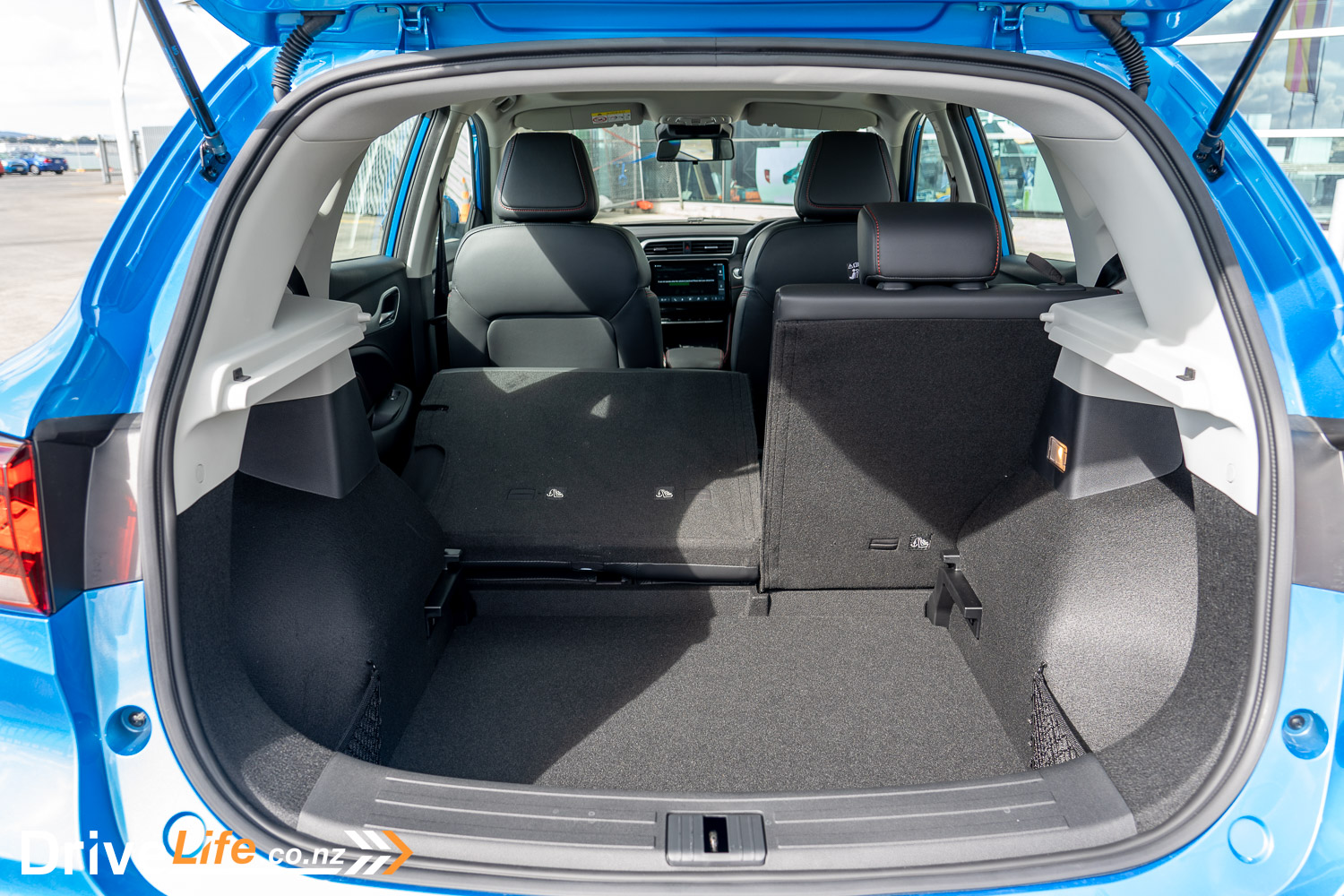
What’s The 2022 MG ZS EV Essence Like To Drive?
After the ZS EV’s launch yesterday, I charged the car up to 100% at a free Vector charger in Hobson Street, Auckland City. Not sure why, but it would be great to have a few of these free fast chargers in Wellington! Just saying. Regardless, with 319Km of range showing, early on a Friday morning the 2022 MG ZS EV and I hit the road south, heading home some 652Km away.
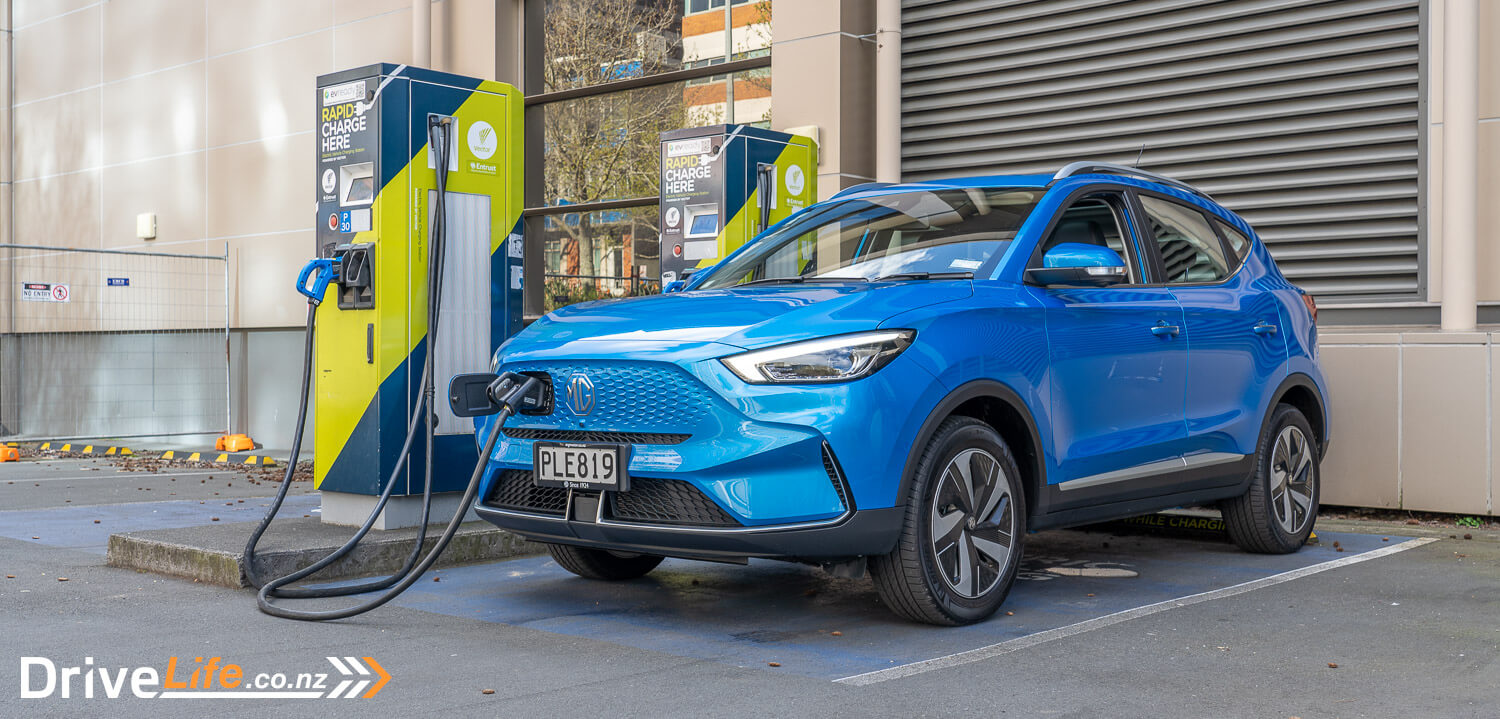
That 652Km should only need one charge, maybe two, and the day is clear so far with no rain to suck out battery power, and no tail or headwind to help/hinder progress. This should be a great test of the car’s range. I aim to leave the car in Normal drive mode whenever possible to replicate someone else just jumping in and heading south. I don’t expect everyone would consider putting the MG into Eco mode, so Normal mode is it for today.
I played around with the idea of taking a more scenic route, perhaps through Te Kuiti, but ended up sticking to SH1 all the way home. I really wanted to check out the new Waikato Expressway (at last, Hamilton is bypassed!) and I guess if there was another reason, I need to be sure I had a good supply of charging stations to pick from. I wanted to run the ZS EV as low as possible so I could really determine its real-world open-road range.
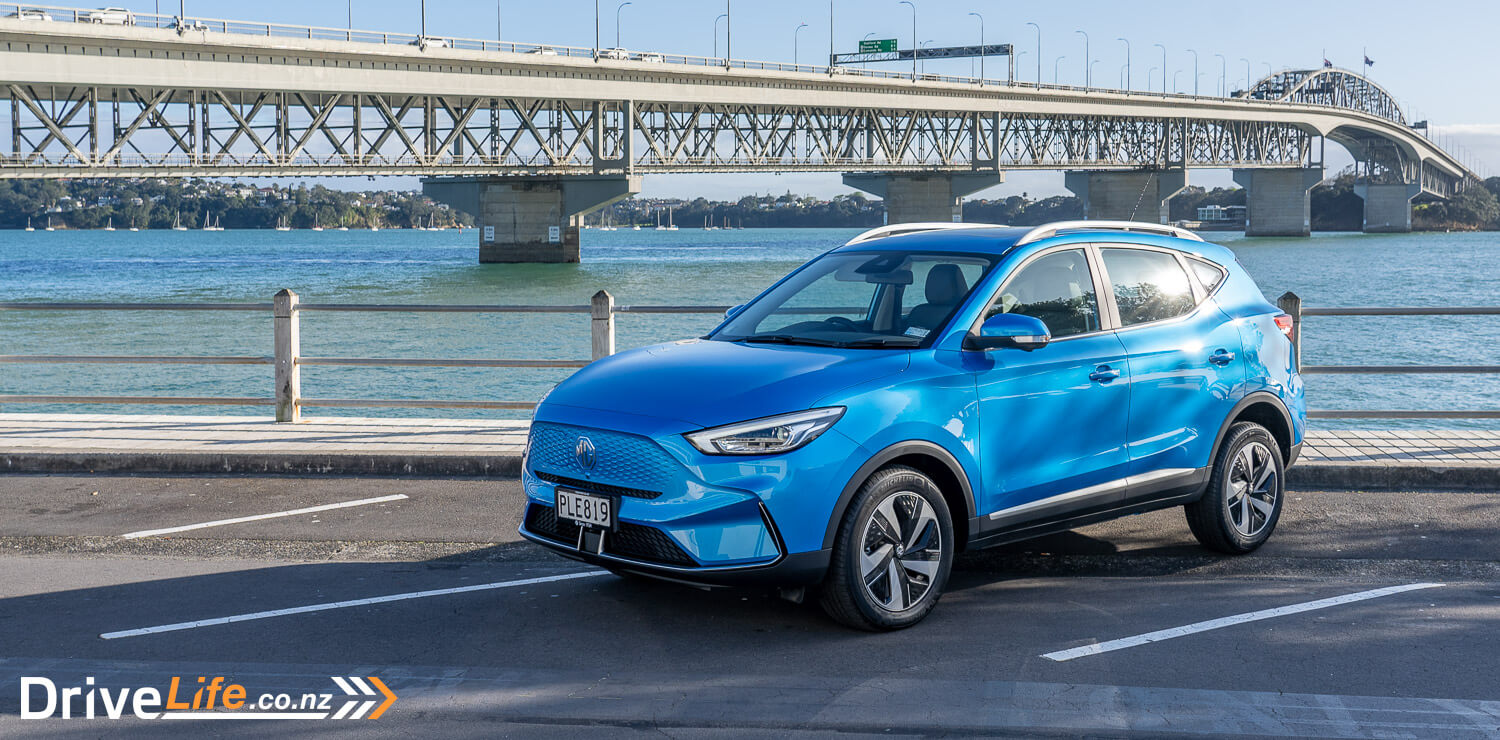
On the Southern Motorway, things started off well. As mentioned in the launch article, the car is supremely quiet at 100Km/h. There’s a little wind noise from the A-pillar, but on smooth asphalt at least, it’s whisper quiet inside the car.
It’s not quite the same once you get off that smooth asphalt, as those Michelin Primacy tyres can be quite vocal on most other surfaces. Still, on the whole, it’s an improvement over the previous model.
While cruising on the motorway, time to check out some of the infotainment changes. There’s no doubt it’s a massive improvement over the previous gen of ZS EV; gone is the lag, and (mostly) gone is the infuriating menu system. It’s all fairly simple and standard now, and easy to use. I did find the soft buttons on the screen sometimes took a few pushes to make them work, but that’s not the end of the world. Weirdly, but in a good way I guess, there are hard buttons below the screen for doing, well, many of the same things. There’s a Home button, volume button (not a knob, dammit), AC menu button, front and rear demist buttons, fan speed and temperature adjust buttons.
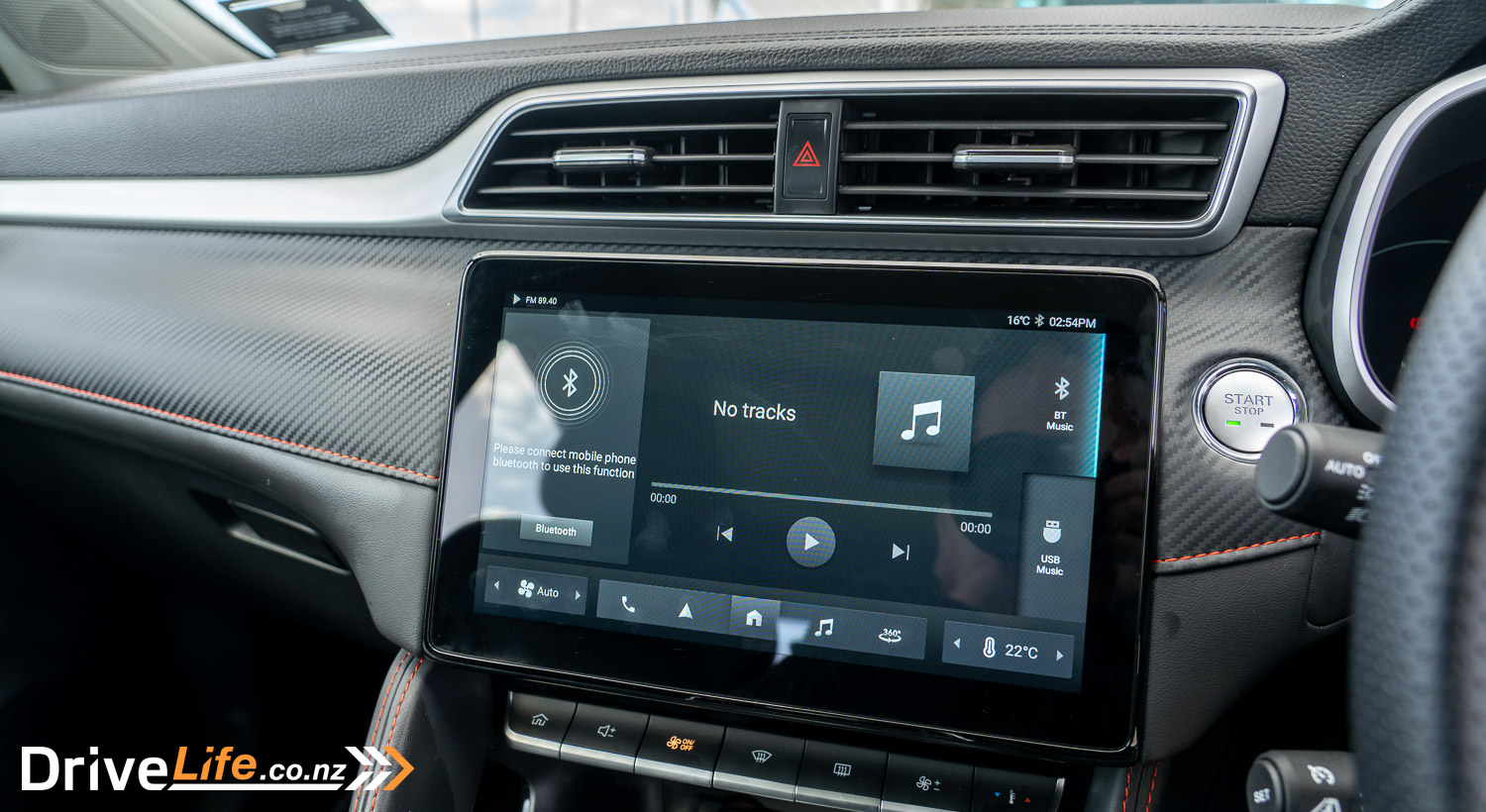
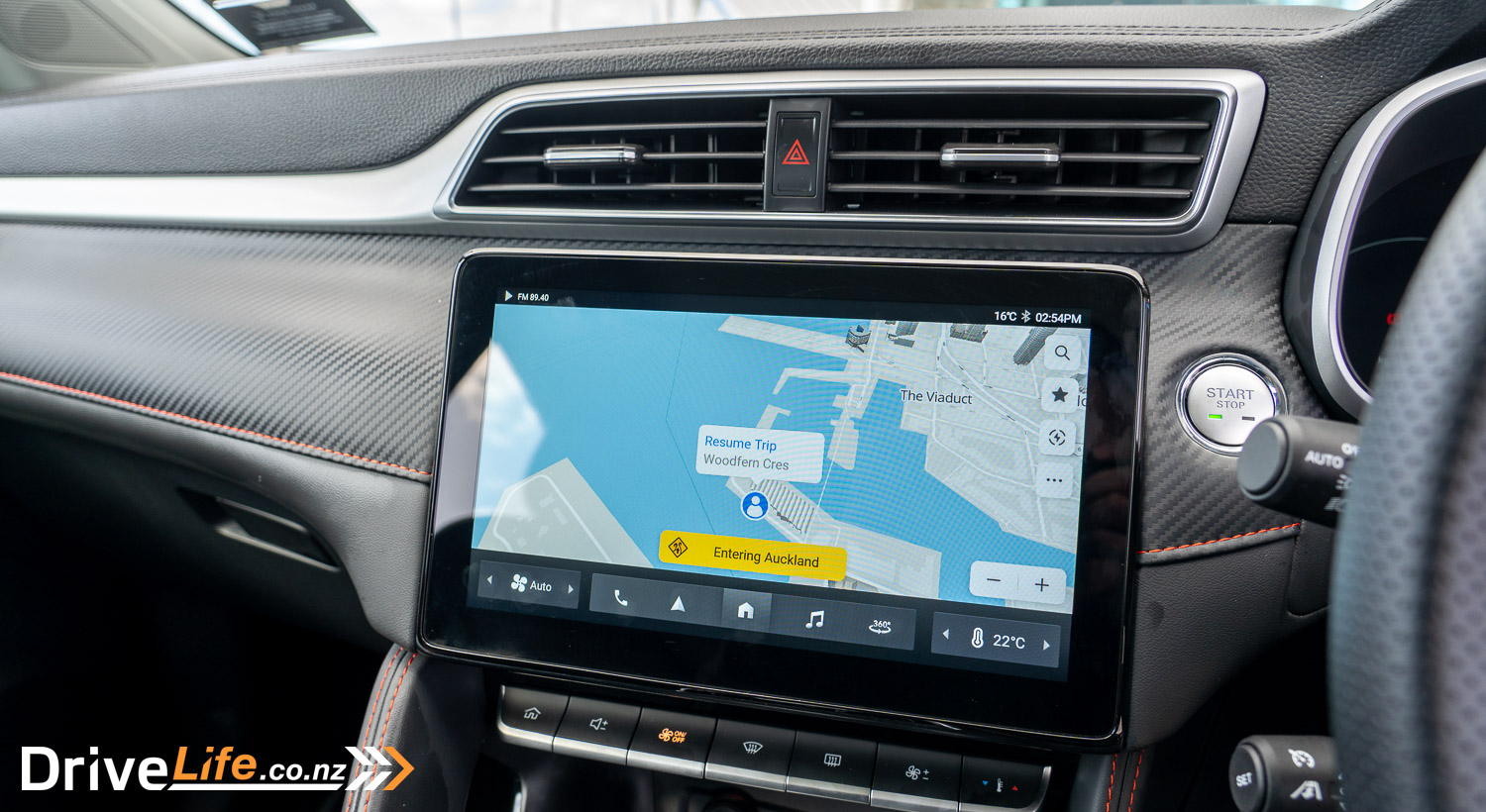
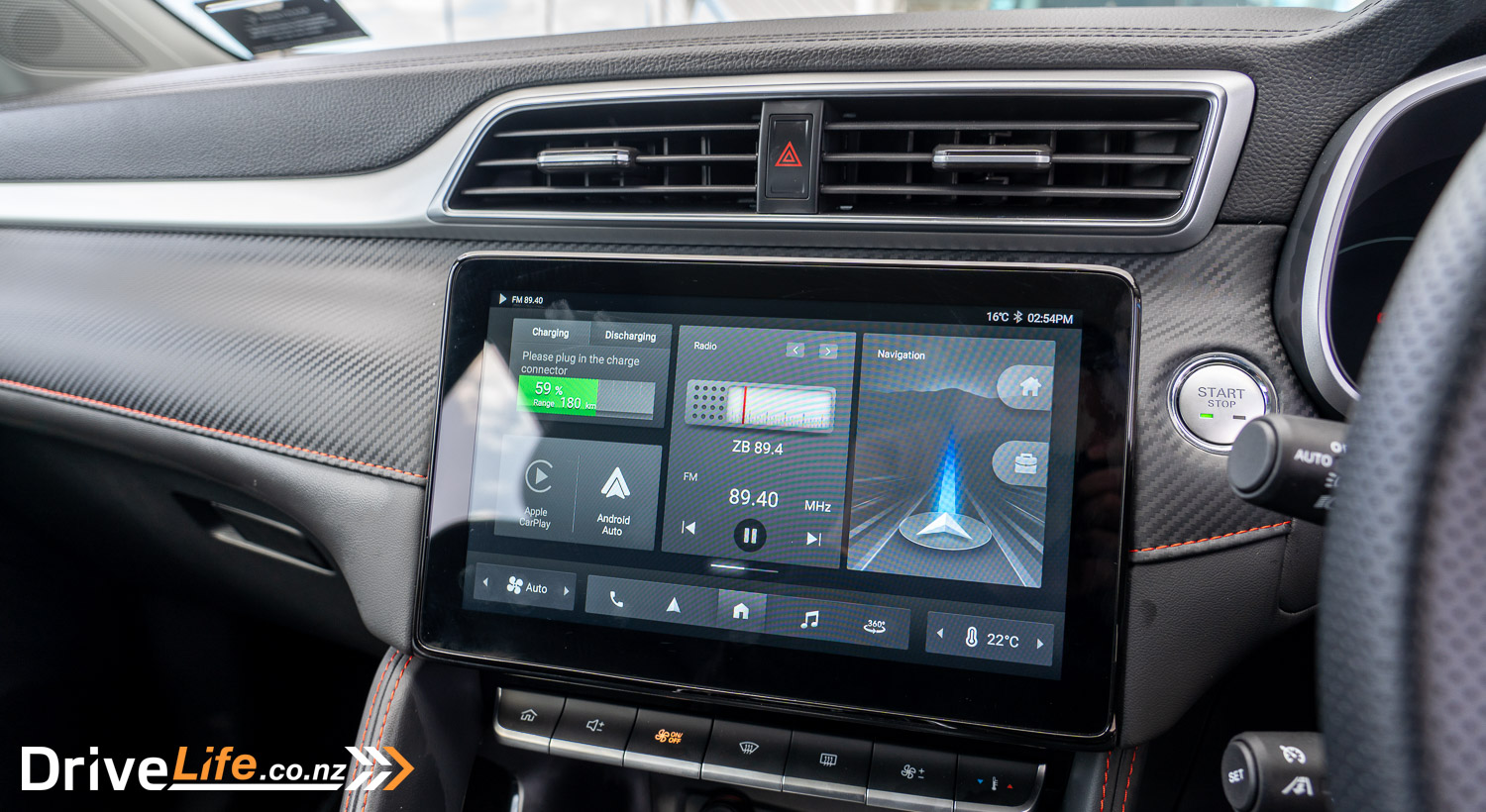
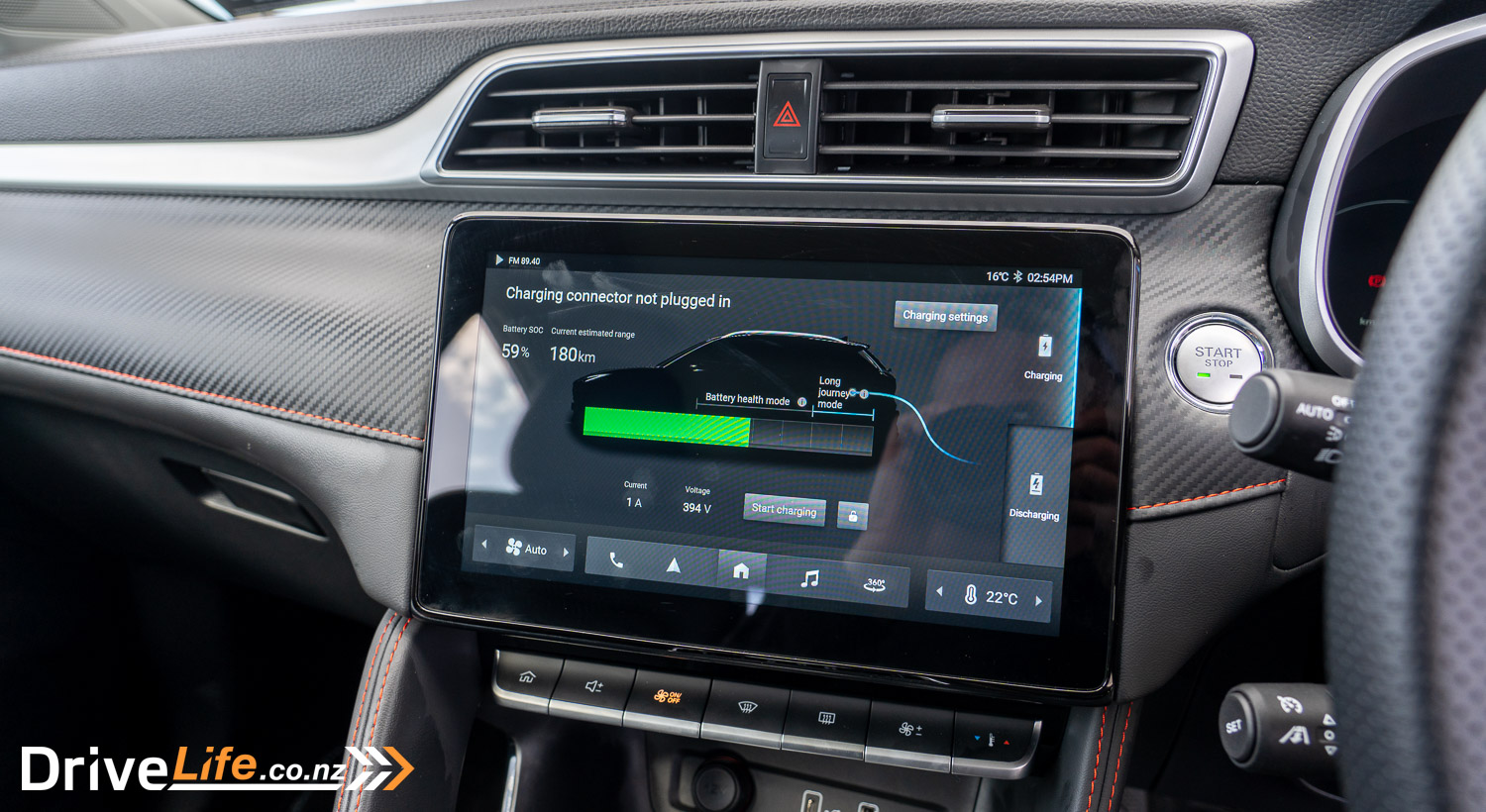
But the menu system on the screen itself replicates these. Still, using a physical button in a car while driving is always easier, and safer.
Getting into a traffic jam on the motorway, and the 360-degree camera system turns itself on when a neighboring car decides to enter my lane without warning. That’s a nice touch, although I am finding that the lane-keep assist system is fairly aggressive; it doesn’t just try and nudge you back in your lane if you drift a bit, it moves the steering over very quickly. It’s a bit disconcerting to start with, and I ended up switching it off. Getting to it in the menus isn’t that quick, either.
I’m using MG’s SatNav for the return drive home to Wellington and it’s pretty easy to use. Set and forget, although I was a little disappointed that Satnav directions do not show on the driver’s virtual cluster at all – they are only shown on the centre screen. The SatNav girl will call the directions out to you of course, but it’s been some time since I’ve been in a car and used SatNav and not had the directions on the driver’s display.
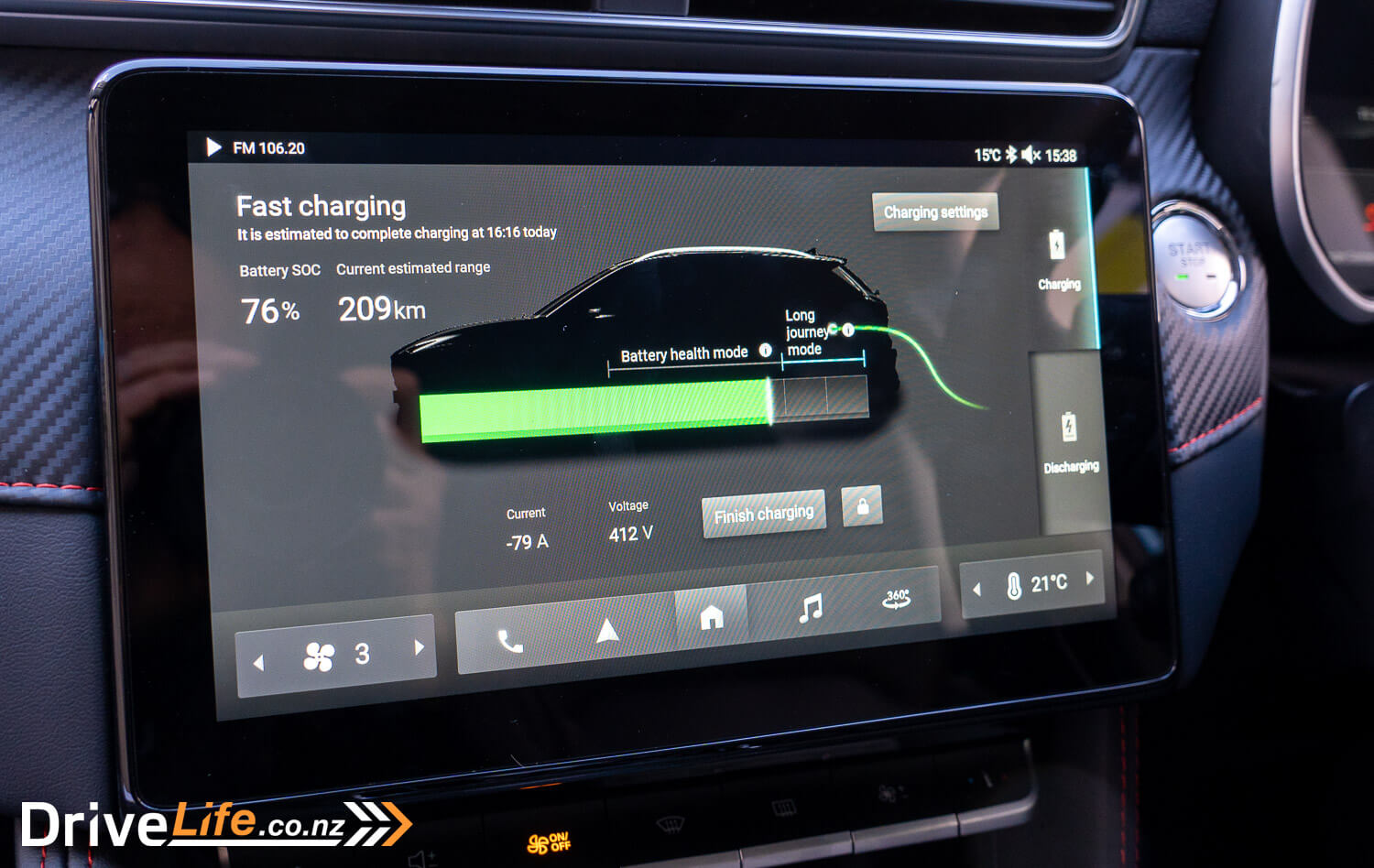
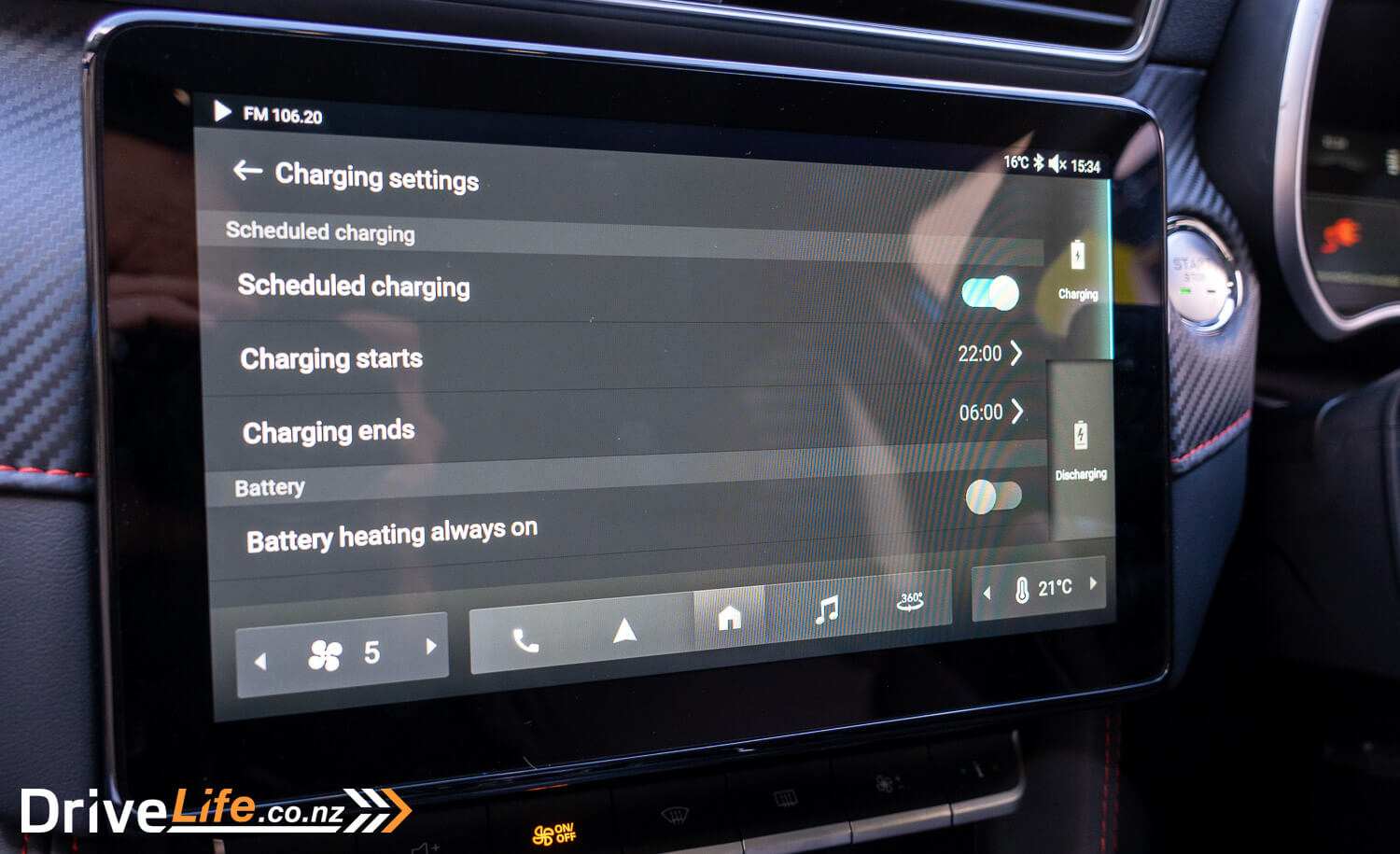
One of the features of using SatNav in the MG is that it can show you just how far you can get with your current range, on a map. There’s a clear ‘box’ in all directions giving you an idea of your maximum distance. I saw Taupo as a viable destination with my range at the start of the trip, but as the trip went on, this reduced slowly. One of the issues here is that there is only a charger in Tokoroa, and nothing else in-between Tirau and Taupo – just Tokoroa. So it looks like that’s going to be my first charge point.
Another bonus on the SatNav when checking out that range is the button to show where the charge stations are. Not all EVs do this so it was great to see MG included this feature. Still on SatNav, the current speed will be shown on the centre screen, as well as the driver’s display. But the two often don’t match. I assume it’s because the driver’s display is using Traffic Sign Recognition (TSR), and the SatNav is using satellites, so perhaps the SatNav hasn’t updated for the Waikato Expressway, showing the road but having a 100Km/h speed limit on it. The TSR on the driver’s display showed the correct 110Km/h.
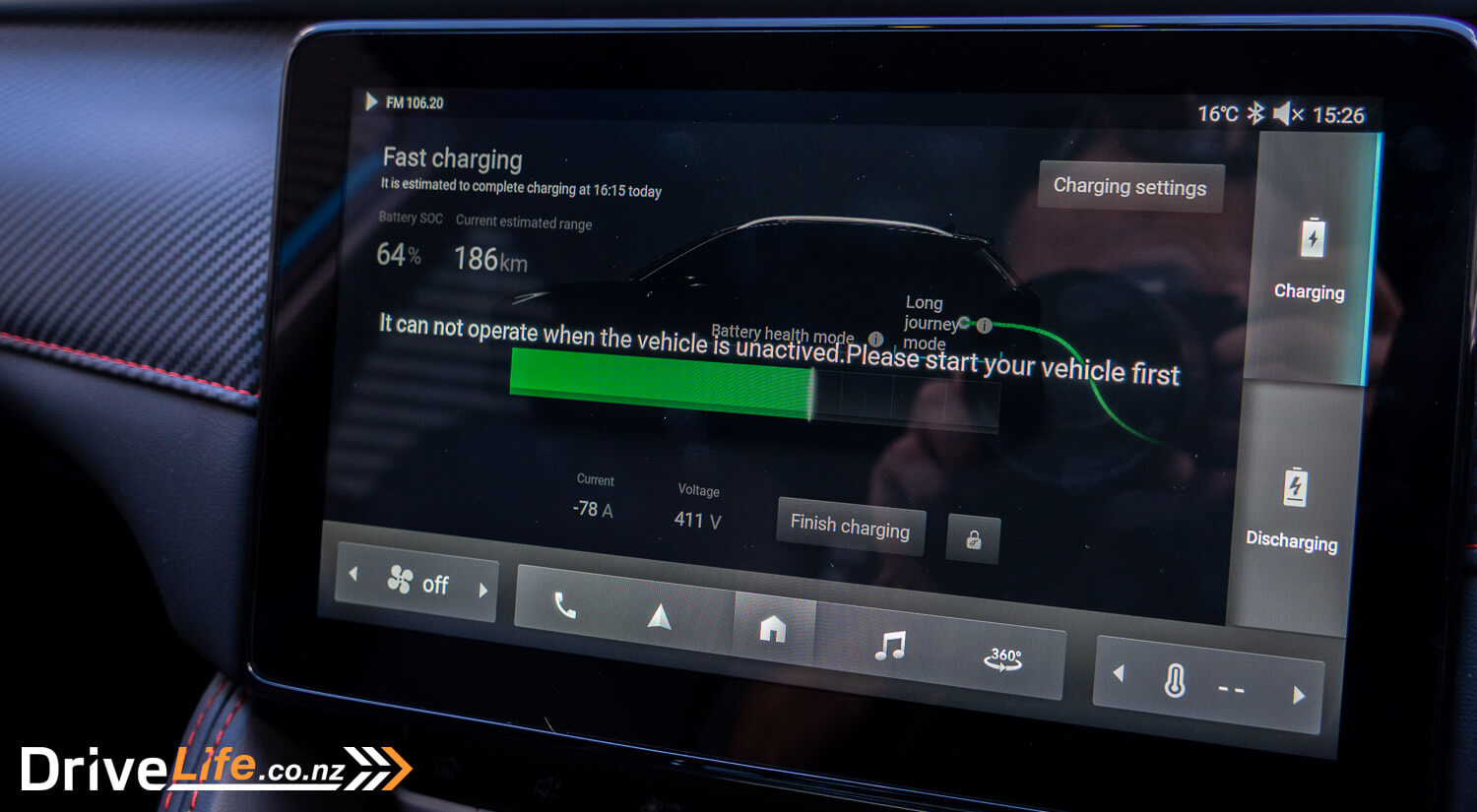
The steering wheel controls seem the same as before and that’s fine with me. They’re simple, clear and work well. The ZS EV has its adaptive cruise control on a stalk on the left side of the steering wheel, and it doesn’t take long to realise how it works. Actually, I’ve never been a fan of cruise control on a stalk, but this one on the ZS EV is the best I’ve used and I think I could live with it. The steering wheel itself is flat-bottomed, which is fine, but the feel of the wheel is not the best. It feels like plastic instead of leather. It’s not terrible and the wheel looks good but it’s let down by the tactile feel of it. One thing that did surprise me is that the steering wheel doesn’t have a telescoping adjustment, only tilt. While it was fine for my length of arms, that was a surprising omission at $54K.
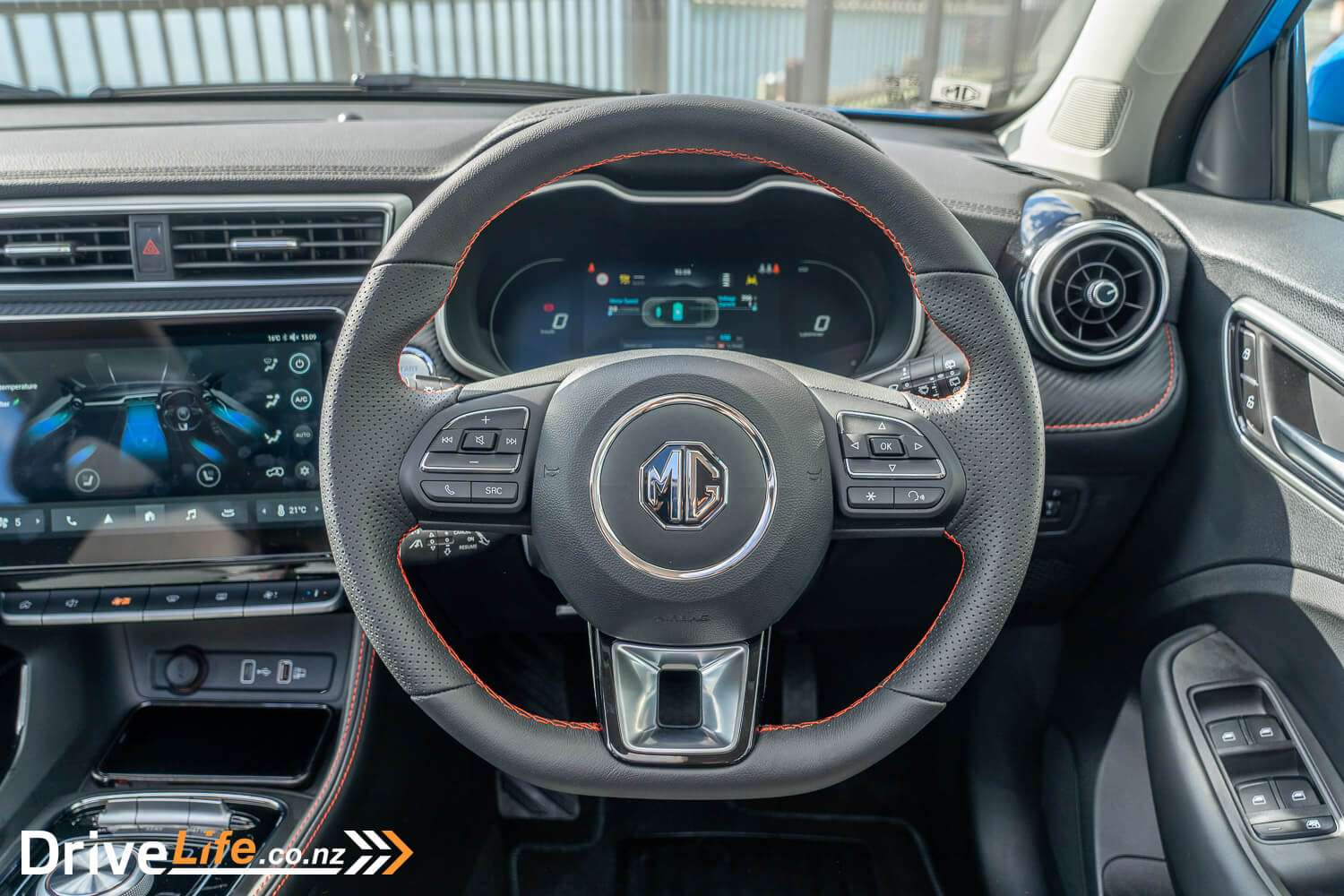
With 50Km of range left, I got a warning on the centre display that I should start looking for somewhere to charge. Tokoroa is still my desired charge point, but I did click on the button on that screen to show me where the nearest charge points were. Tokoroa appeared first, and weirdly Wairakei Thermal Area came up as the second option, some 65Km away. I wasn’t going to make it there. I hit the selection for Tokoroa and was asked if I wanted to set that as a destination, and I did. Again, not all EVs do this, and it’s appreciated that MG does.
Pulling into the ChargeNet station at the New World in Tokoroa, time to look at the numbers so far. I’d driven 212Km at an average of 75Km/h, the car had used 19.3kWh/100Km and I had 35Km of battery left. Based on that, the real-world open-road range for this car in that weather with only me as a passenger would be around 250Km.
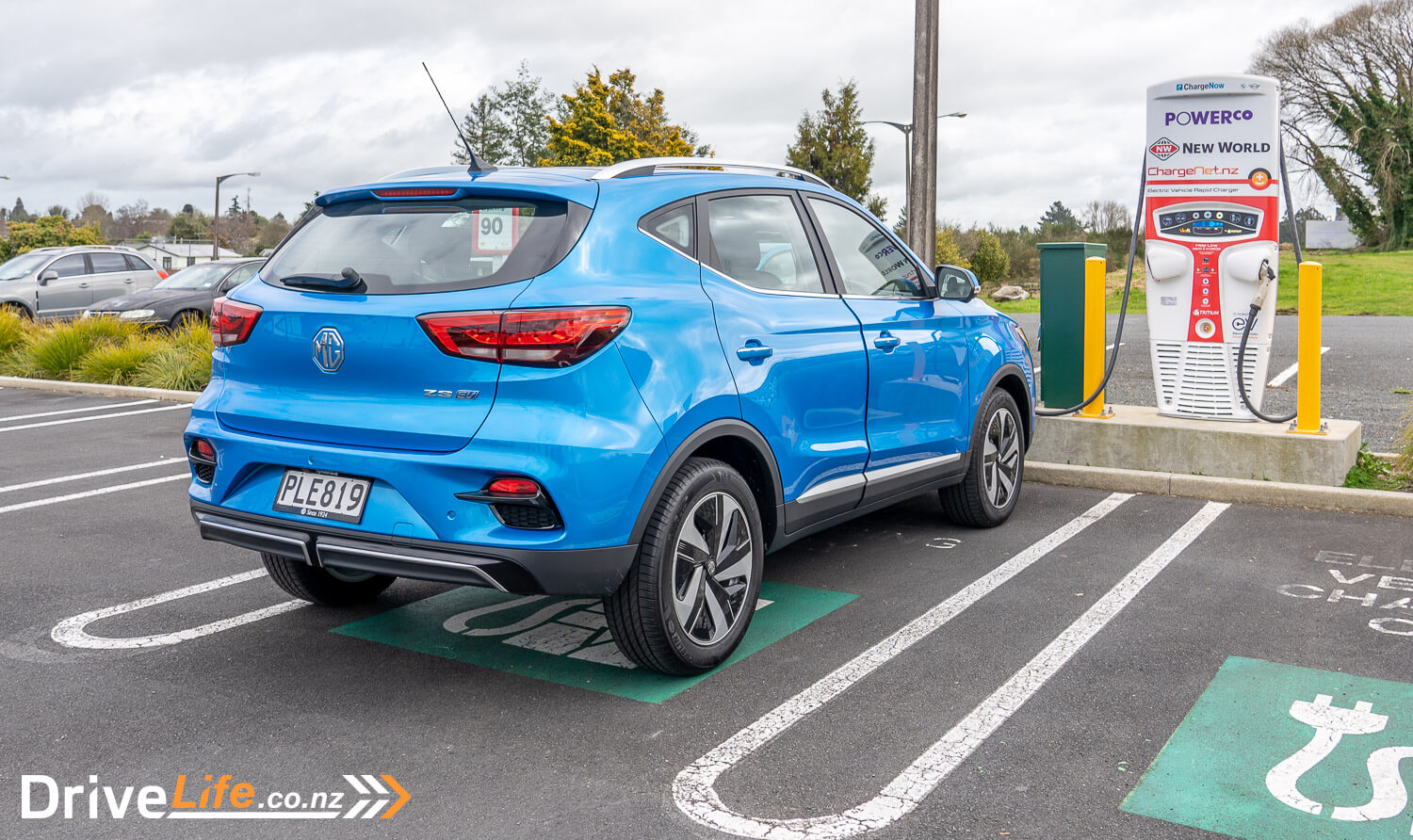
Taking the car from 14% to 80% after 38 minutes of charging cost $18.80, and I hit the road again. I’ve only charged the car to 80%, which is normal when travelling. Getting the car to 100% would take a lot longer, so there’s no real point.
On the road again with 210Km of range, time for a seat check. On the whole, pretty comfy although I miss having no lumbar adjustment at all. The driver’s seat on the Essence model is powered, while the base Excite does with manual seats up front. The top-spec Essence has heated front seats, but they are only a 1-stage unit – so they are heated, or they’re not. It’s been a while since I’ve been in a test car that had single-stage heated seats, and I’ve got to say after a while, the driver’s seat went thermonuclear and I had to turn it off.
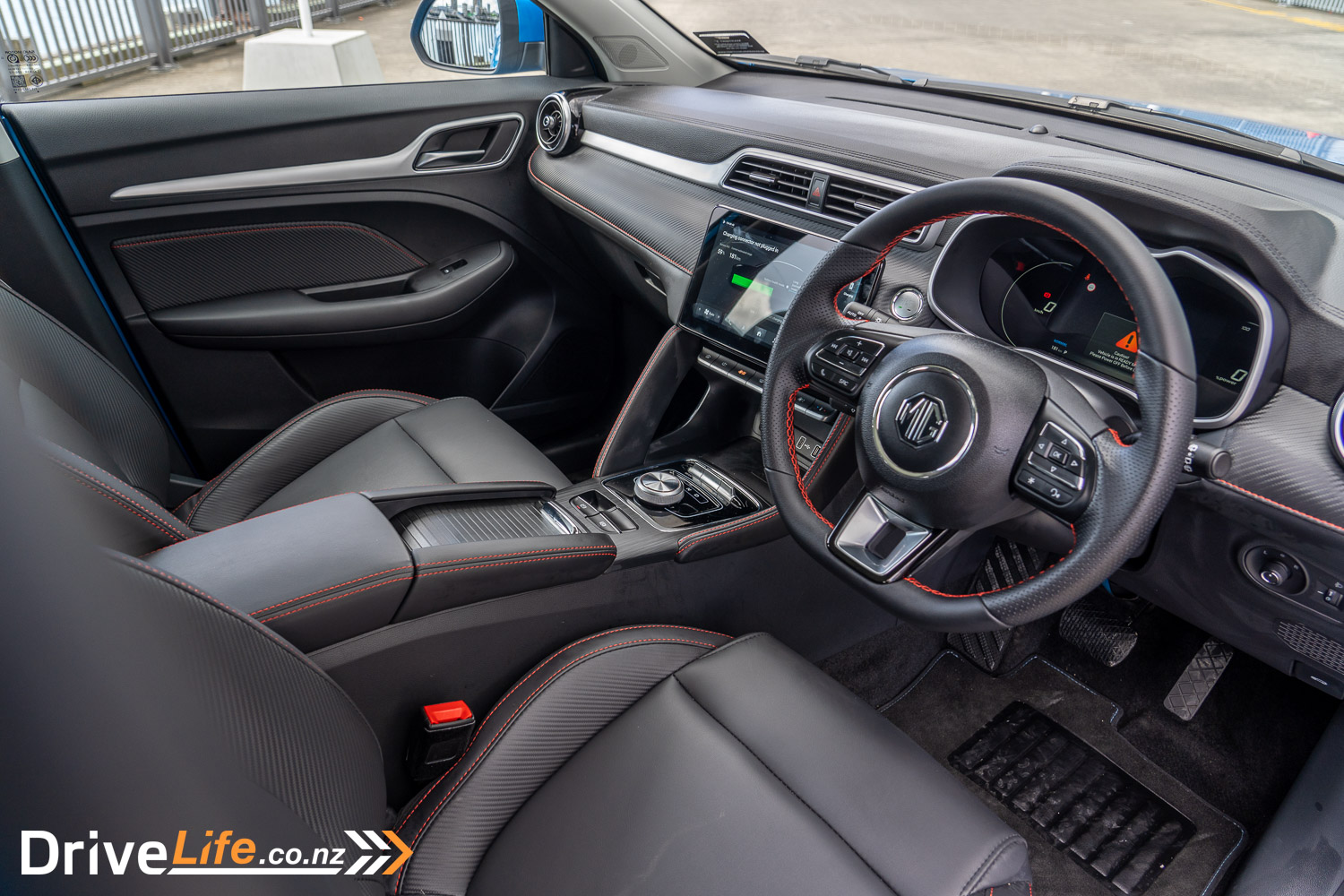
Hitting some roadworks with a Stop/Go guy, it was nice to note that adaptive cruise will bring the car to a full stop, and then you can tap the accelerator pedal to get moving again.
I used adaptive cruise quite a bit on this next leg and noticed that the car slows down for corners, like Mercedes Benz and BMW. Adaptive cruise in the latest MG ZS EV appears to be a route-based system that determines if there is a corner, and how much it should slow the car down when you are using adaptive cruise control. I don’t recall this on the previous generation of ZS EV and so am assuming it’s a first attempt by MG at this safety feature. It’s a nice thought – lots of people freak out when they have cruise control set at say 100Km/h and then come to a corner. But like Mercedes-Benz’s first attempt, it’s a bit too overcautious, slowing the car down to 75Km/h on some corners that would be comfortable at 90Km/h or more. I ended up turning off cruise control, as this feature seemed to be using more battery power than if I drove the car myself.
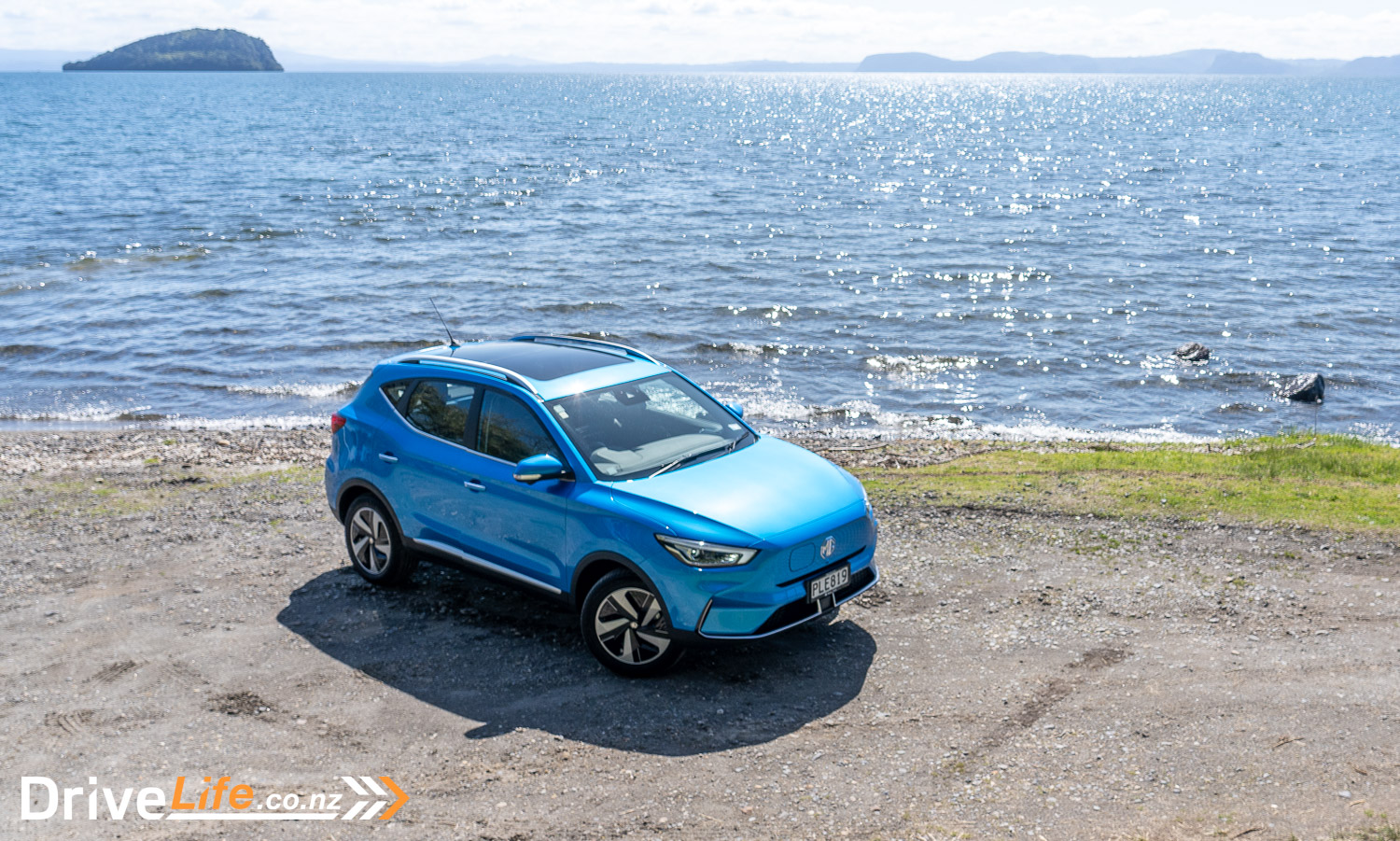
Getting nearer to Turangi, I needed to think about my next charge location. I had 107Km of range left and a 63Km drive to Waiouru, so I could charge up now, or risk it all and go for a charge at the Army Museum. If my wife was with me, I’d have no choice but to charge at Turangi, but she wasn’t with me so it was time to throw caution into the wind (turbine) and gamble my distance. I did have a 40Km buffer, but then I forgot about that long, slow climb south of Turangi. That sucked a good 10Km out of my battery. I will admit to switching the car to Eco mode at the top of the hill, just to be sure. I rolled into Waiouru with a whole 15Km of charge left. Too easy.
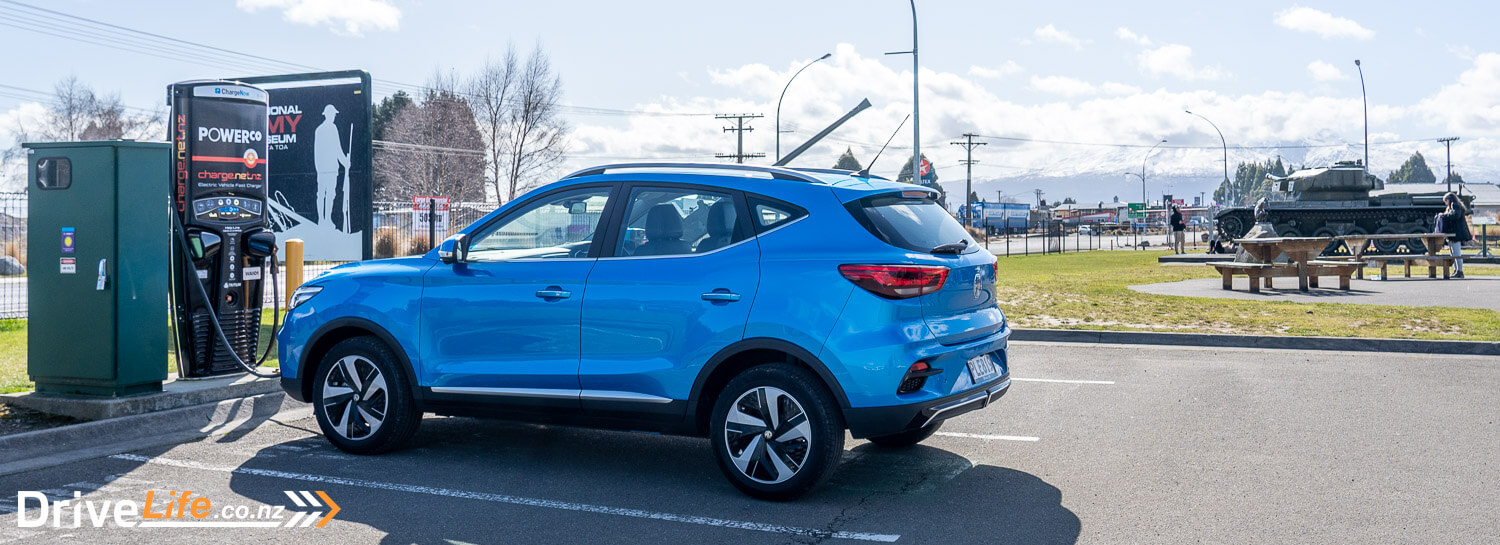
While charging in Waiouru, I set up MG’s iSmart app. It’s a new feature for this generation of ZS EV. Binding the car to the app was easy, and then I had some small control of the car. Other than monitoring things like if the doors are locked, there’s not too much you can do with the app just yet. You can check the state of charge, check the range remaining, and you can find your car if needed. There are buttons to lock the car, turn the AC on or off or demist the front window. The slightly painful thing here is you have to enter a 4-digit security code whenever you click on one of these buttons, and even after doing that, I just got a ‘failure’ message. The next day, these parts of the app worked just fine. I managed to turn on the AC, and get a message to say it would turn off automatically in ten minutes. It’s a nice way to warm the car up before heading away. Once the AC is turned on remotely, you can use the app to adjust the temperature – after entering the security code yet again.
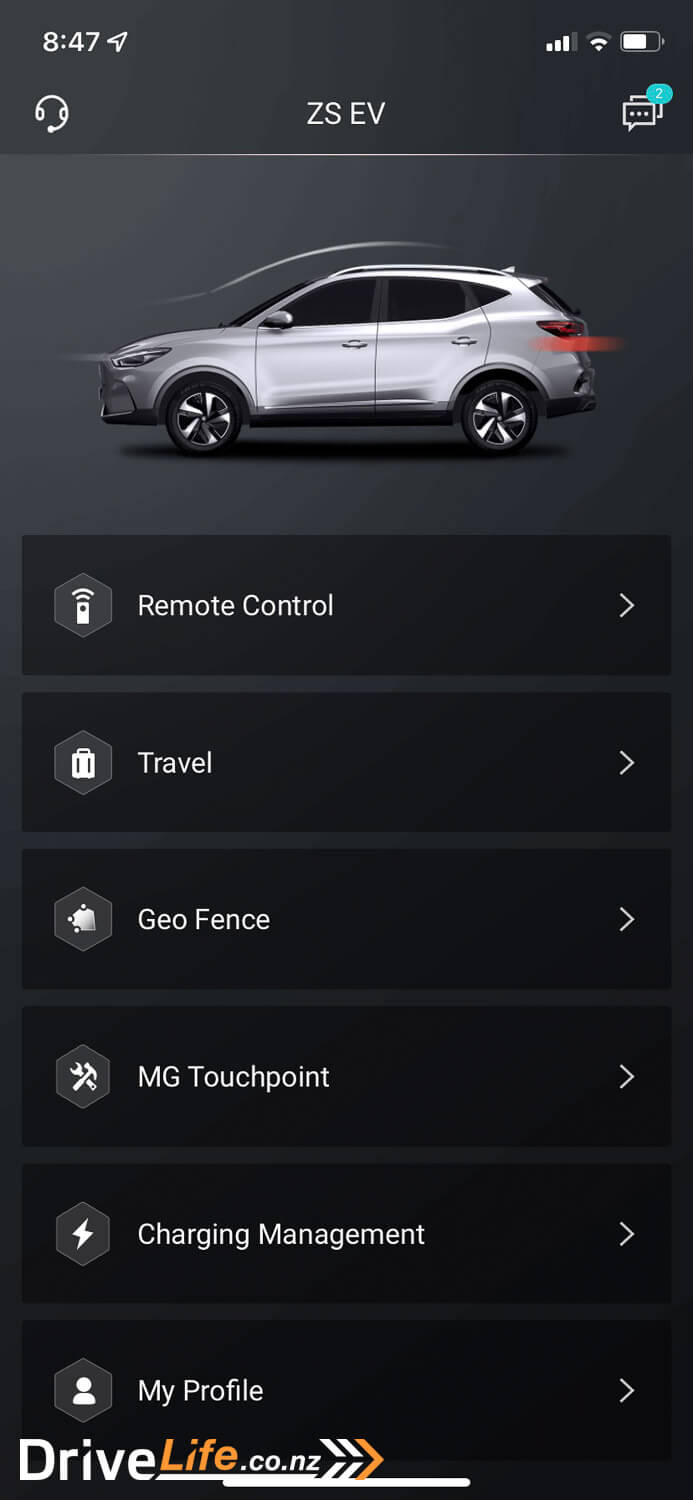
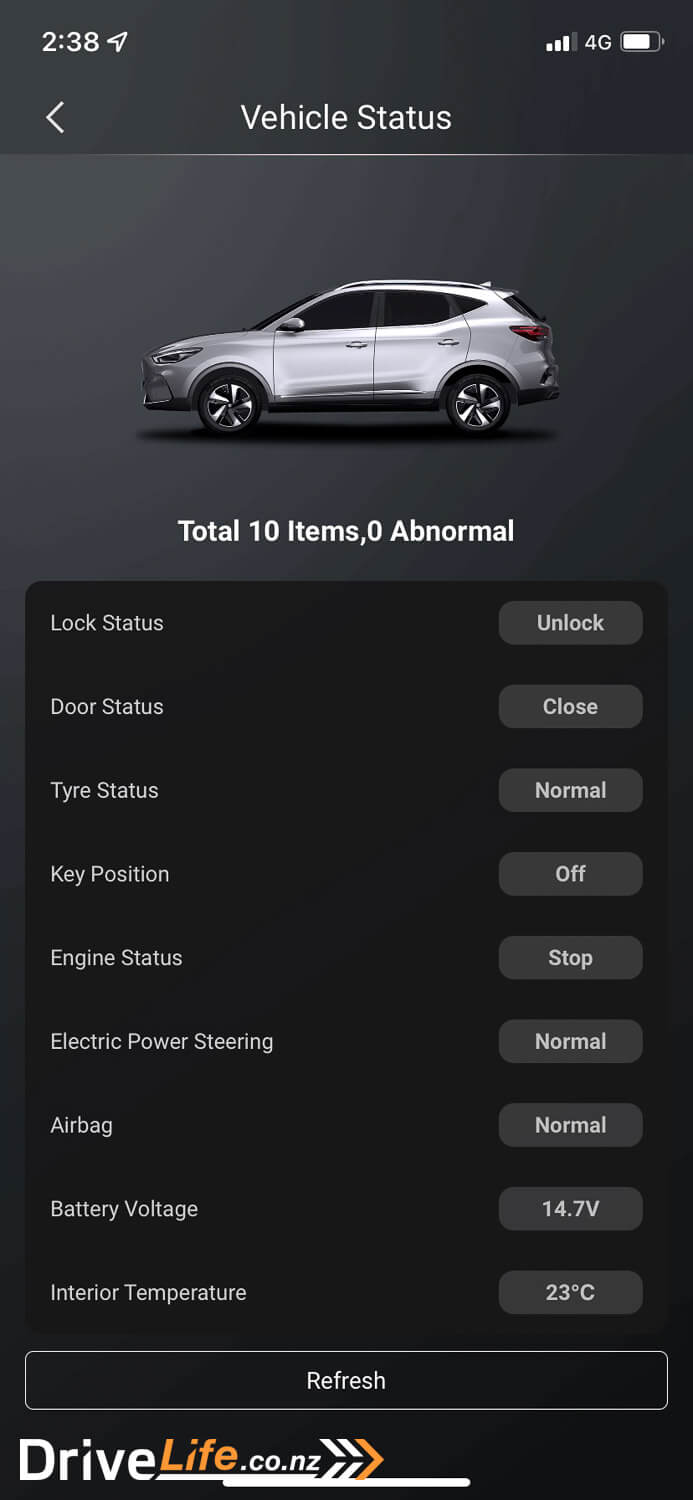
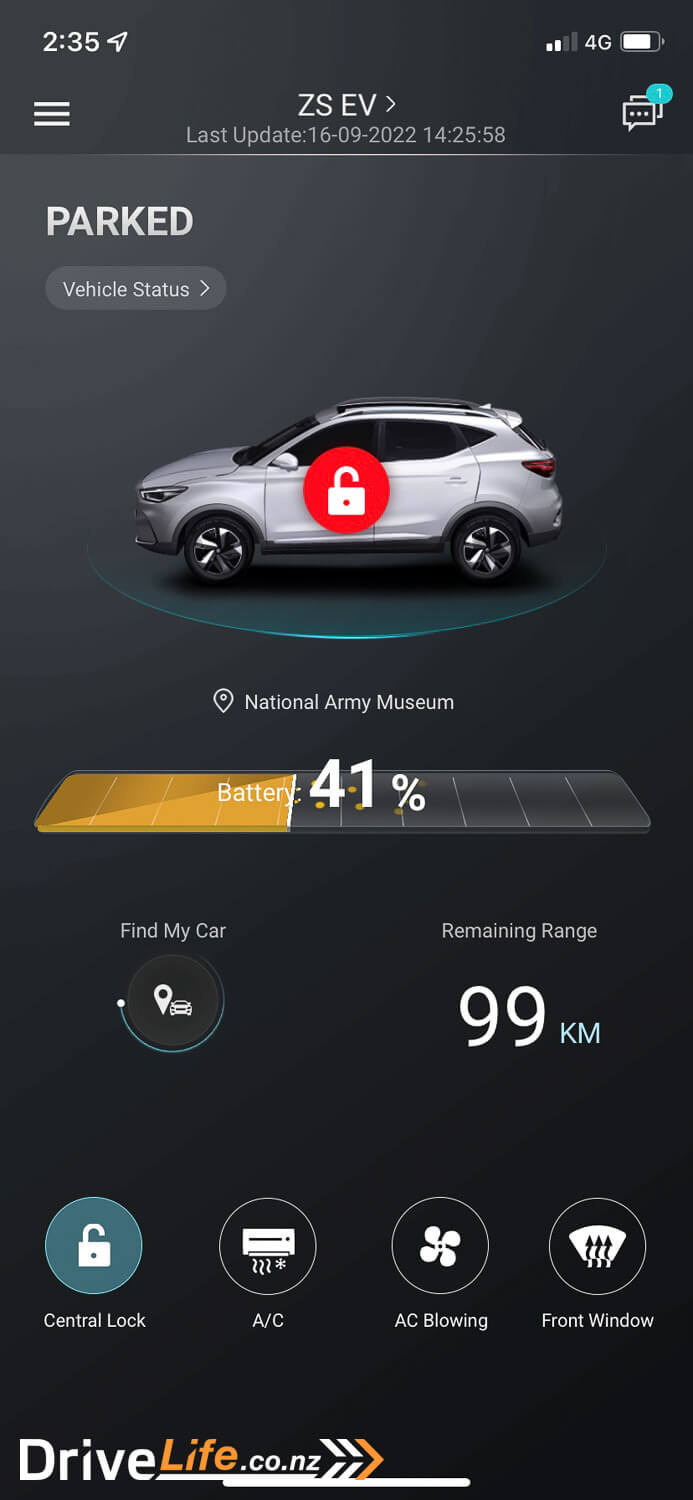
Another feature of the app is to set a geofence. Let’s say your son or daughter is borrowing the ZS EV and they’ve promised to only go to a friend’s house and back. You can use the app to set up a geofence, and you’ll be alerted if the car goes outside the “fence”. It’s a common GPS tracking feature, but not one we see often in car apps. Setting the geofence up easy; head to that part of the app, select your range out from the current location (e.g. 15Km) and hit the set button. You’ll be alerted (app message and email) if the car goes into or out of the circle shown on the screen. You can only set ‘Drive In’ or ‘Drive Out’ of a geofence, and not both. Still, it’s a handy feature for some.
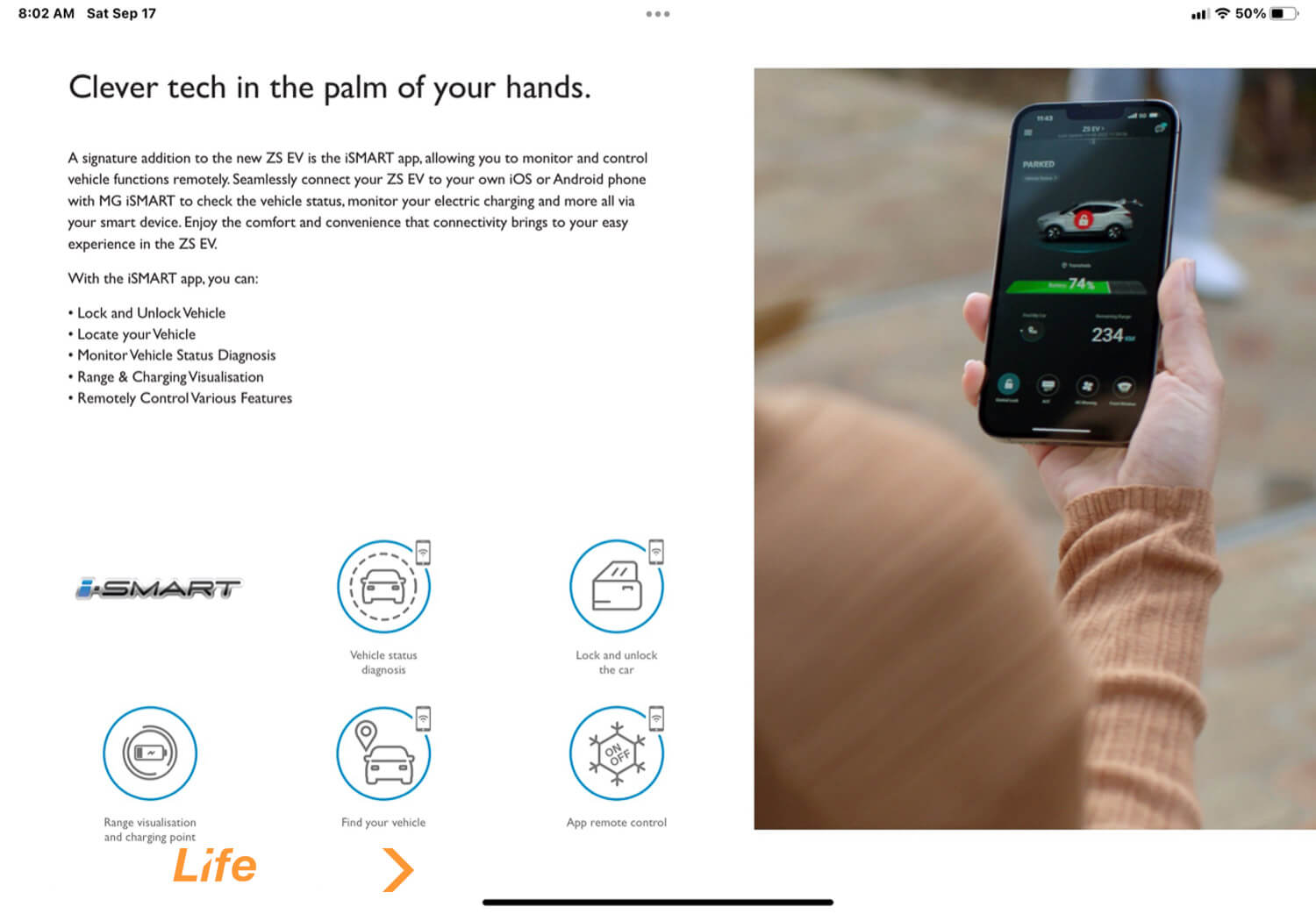
Another 45 minutes and $21.37, and I was off again. The drive from Waiouru south is an easy one for an EV, and I’d done it before in my old Nissan Leaf, and a Kona EV. But with 193K in the ‘tank’ and a 265Km drive home, I’d still be up for one more top-up.
The rotary “gear” shifter works well. The indents are nice and easy to find and it becomes second nature to flick it left or right for Drive or Reverse. Those with reservations about the rotary shifter shouldn’t worry at all.
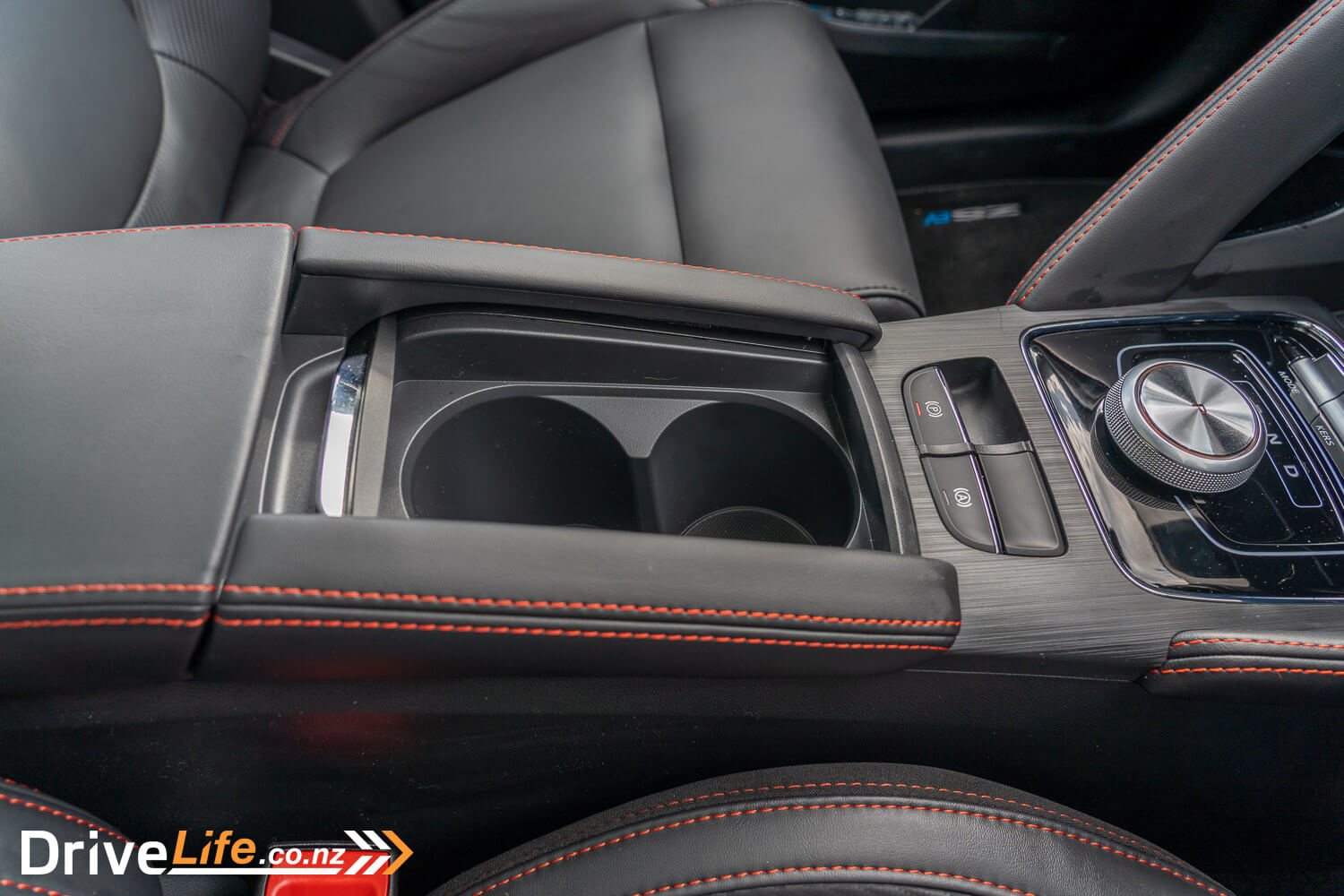
If there’s one last thing that seemed strange on the MG ZS EV, it’s the indicators – they’re really loud. They could be quieter in an EV, but they are not. Again, not the end of the world but I don’t recall the indicators in the old model being so intrusive. Any passengers I took in the car commented on this. Thankfully, you can quieten them down by going into the infotainment system.
So, how does the new MG ZS EV actually drive? Overall, very well. It sits well on the road, although on the motorway there is a very slight tendency to wander. The ride on the car – as is with many EVs and their weight – is excellent, pounding out bumps and irregularities in the road. It’s not a ‘fun’ car to drive but isn’t meant to be. It does what it says on the box, and I doubt anyone will be complaining.
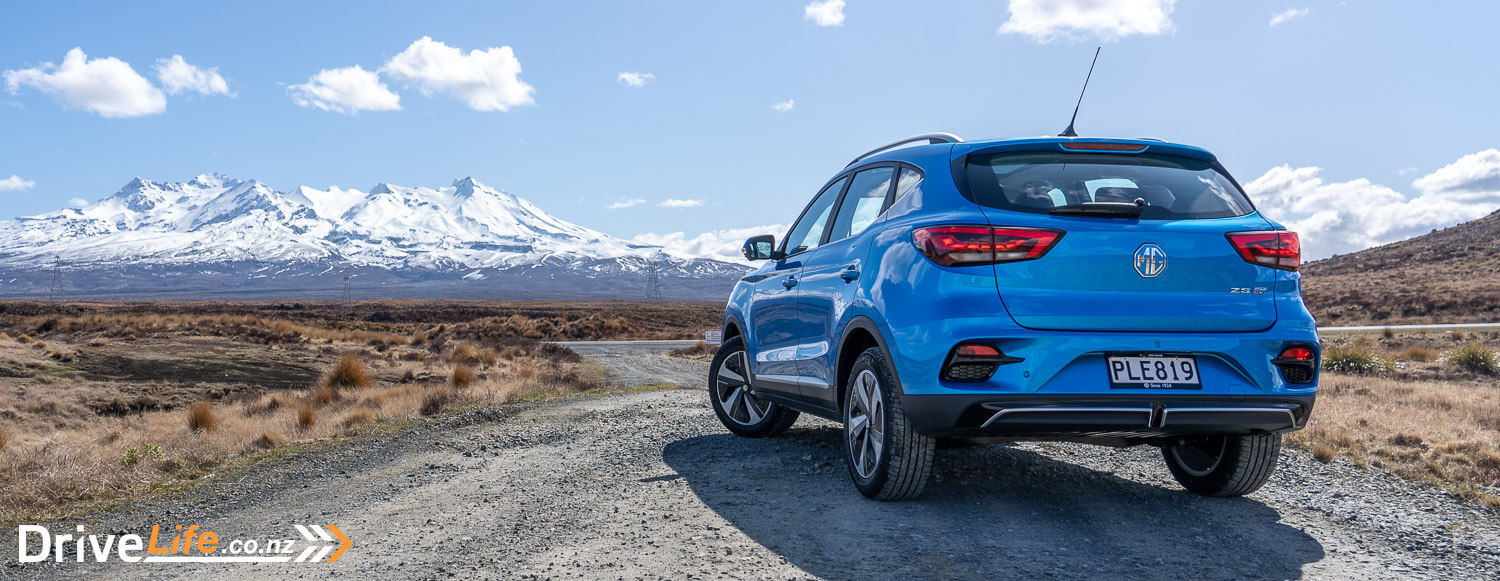
You get three drive modes with the ZS EV, the same as before: Eco, Normal, and Sport. Since power output is up some, performance is improved, and the new model will get to 100Km/h in 8.2 seconds. On the road, it’s peppy enough to get you through gaps and you can make good progress on the open road when passing trucks and trailers. I did use Sport mode a few times and it certainly makes a difference in overall performance. I found myself selecting it in advance when I knew a long straight was coming up, then passing slower traffic, and sticking it back in Normal after that. Switching between Eco and Normal reduces your range by 10Km, as does going from Normal to Sport.
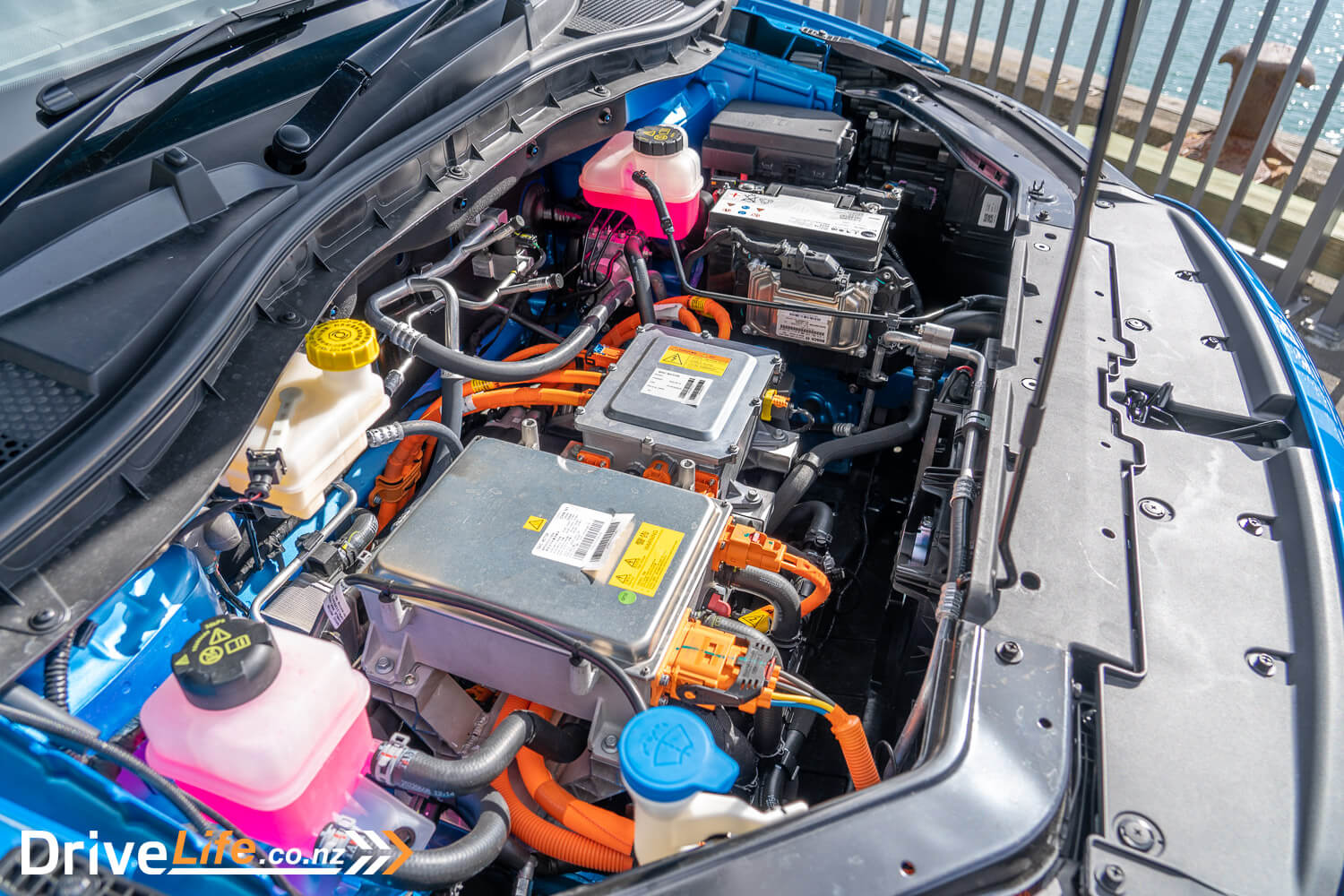
Eco mode is not too hard to live with. Yes, performance is more subdued but it’s still very usable. A shame that you can’t select in the menu system for the car to remember the last drive mode you picked, then you could leave it in Eco very comfortably. But this doesn’t happen on many cars, so it’s not a finger-point at MG.
I stopped next at Foxton to charge up. I could have made it to Levin easily, but that’s a very popular charger and I didn’t want to risk having to wait around. There is nothing wrong with spending 30 minutes in Foxton, cruising around the shops. This was a time I was glad my wife wasn’t with me; time to shop and an empty SUV is a bad recipe.
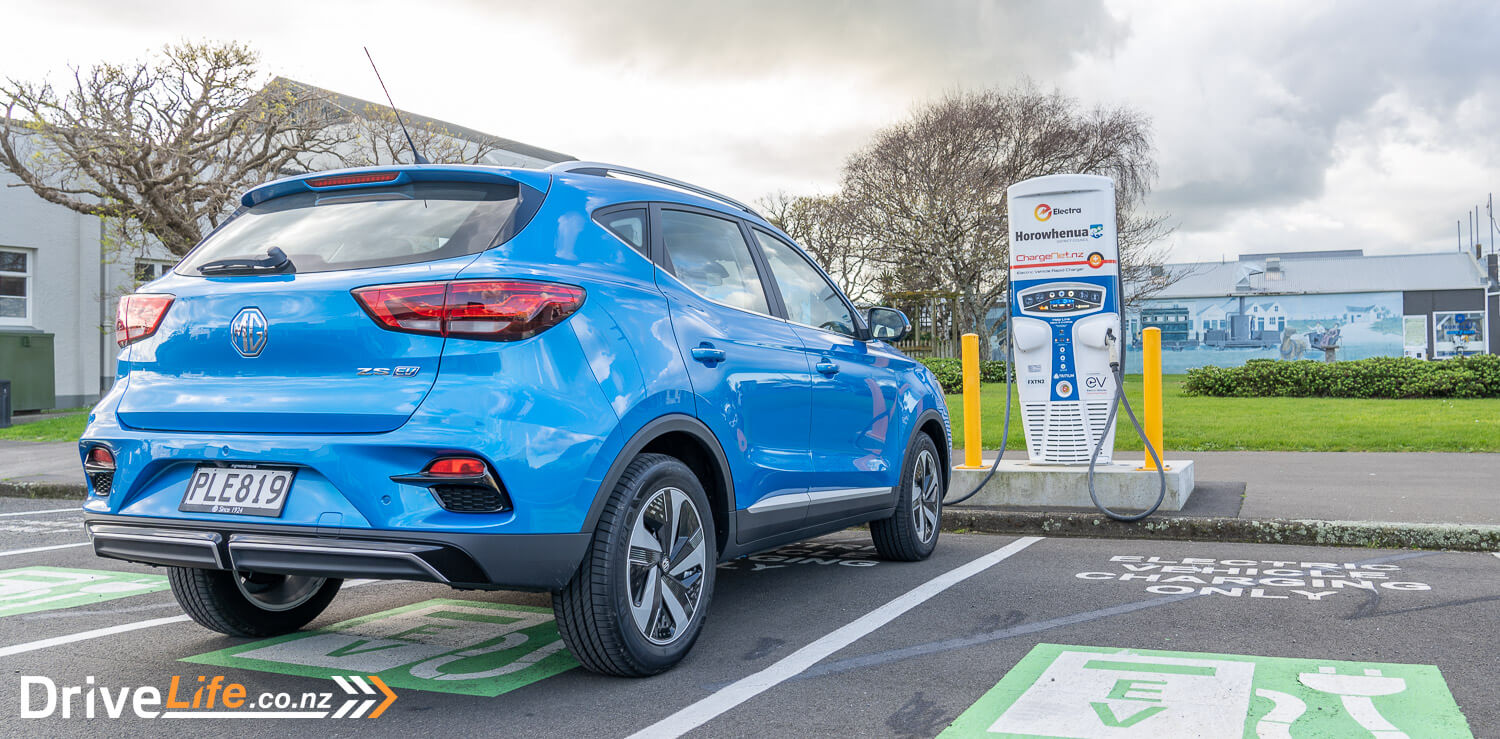
After 25 minutes, $14.41 and 25kWh of charge, I hit the road again to go straight home. On the way, I played around more with the brake regen settings. Like the drive modes, you get three brake regen settings, all selected by a switch on the centre console marked “KERS”. Obviously, the higher the number (shown on the dash) the more regen you get. The highest level isn’t quite one-pedal driving, but it’s fairly strong and should put a reasonable amount of charge into the batteries. On the steepest part of Transmission Gully on the highest regen setting, the car slowed down too much, so I had to switch it to level 2. It did this on Ngaraunga Gorge too, so that gives you an idea of its potential. There are no steering wheel paddles to control brake regen, so you need to lean forward and down to the switch on the console to change it.
After 10 hours of driving and charging, I was home. The total distance was 652Km, my charging cost total was $54.57 and the kWh economy the car returned was 19.1kWh/100Km. This is more than MG’s suggested rating of 18.3kWh/100Km, but that is a combined rating whereas I did one long open-road trip, so understandably, my number was higher.
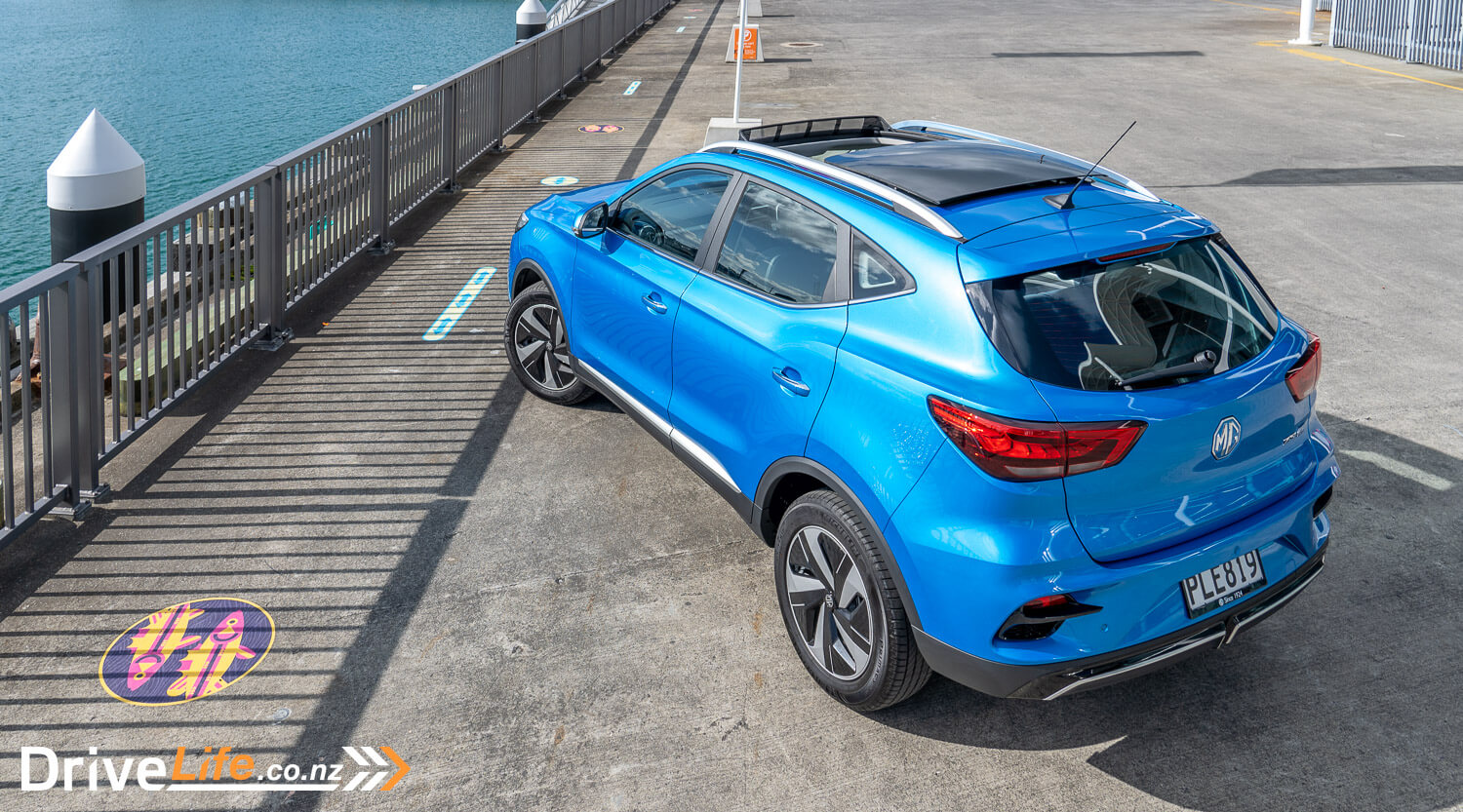
If we compare that total cost to an MG ZS but not the EV model, its claimed fuel consumption is 7.1L/100Km. Working on an average cost of $2.84/litre (at the time of writing this), it would cost around $130 to travel the same 652Km home from Auckland. So it cost less than half of the price of petrol to do this run in an EV, but I did start with a full charge. But even allowing for another charge of say $20, the comparison still ends up at $75 vs. $130.
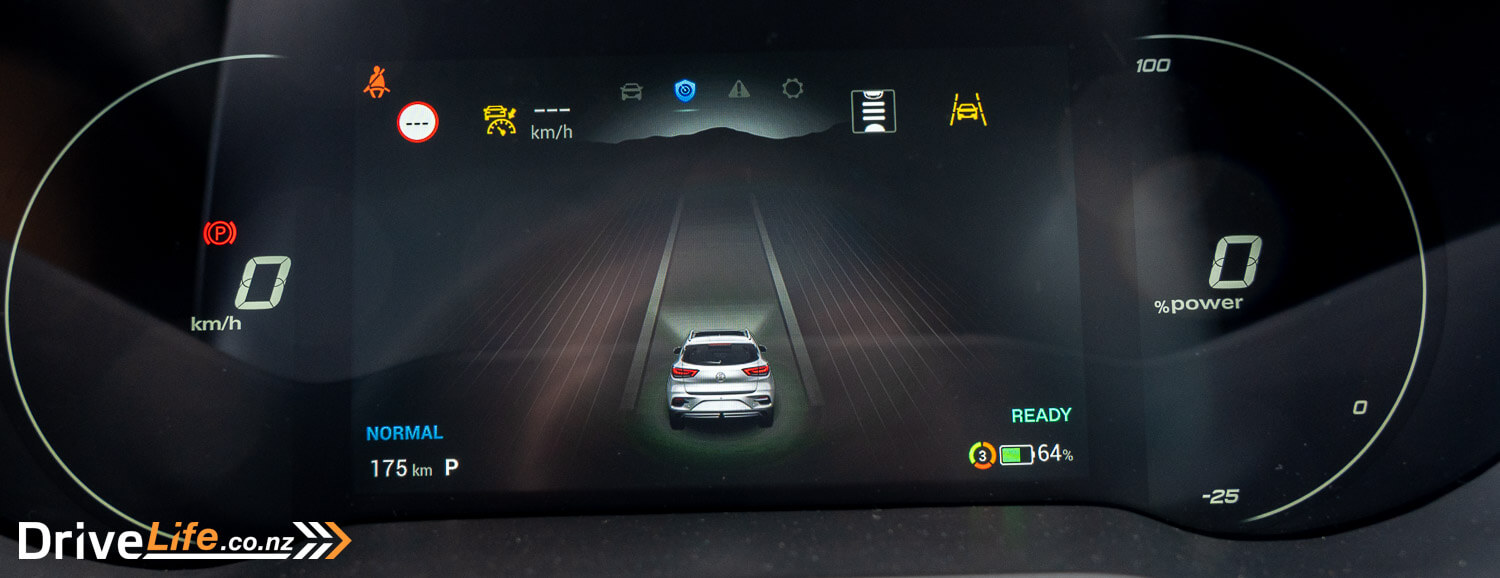
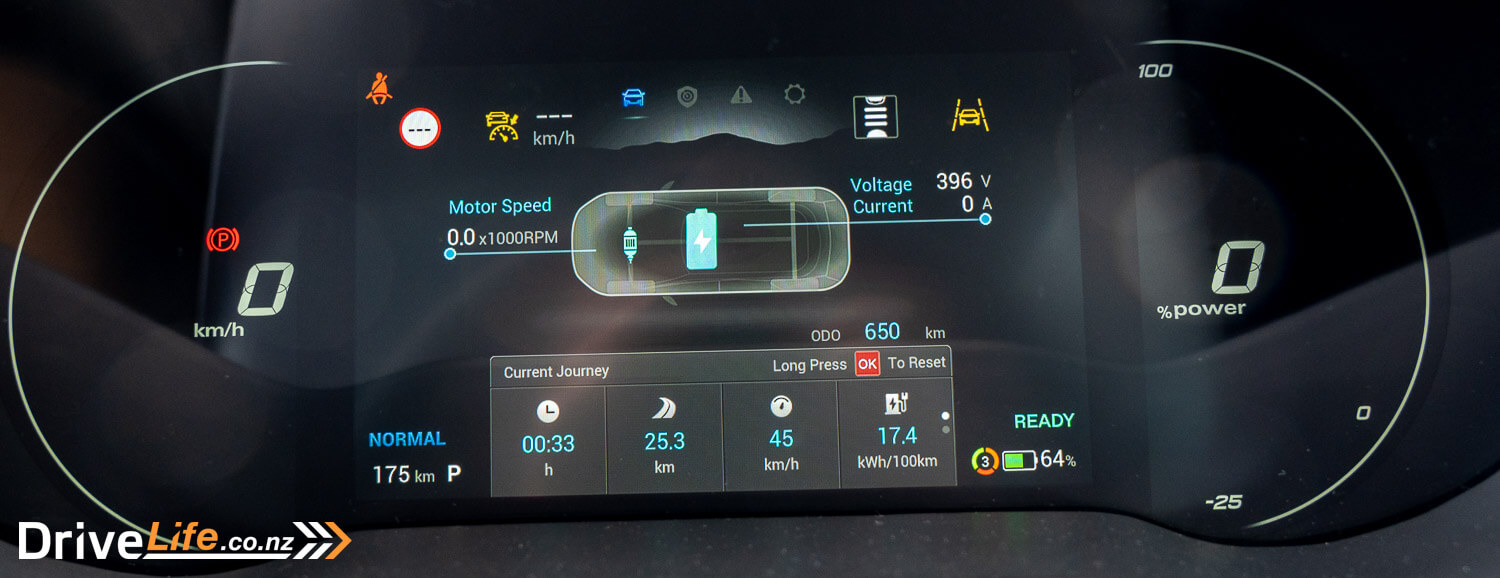
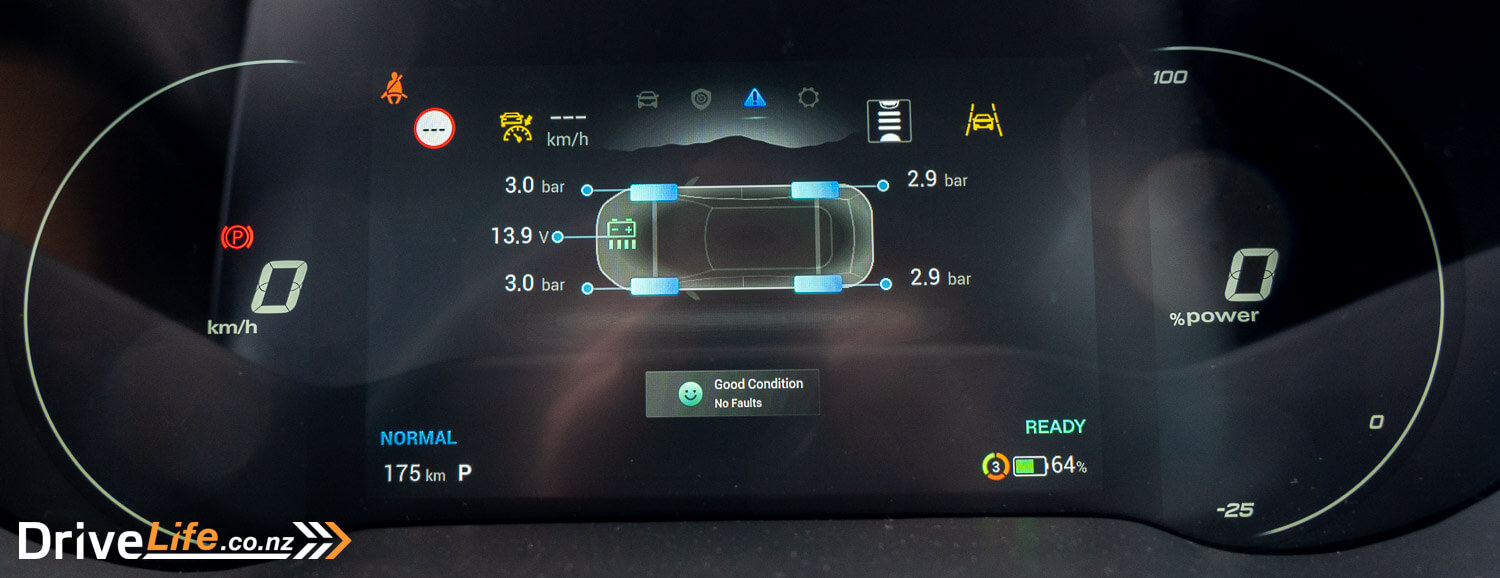
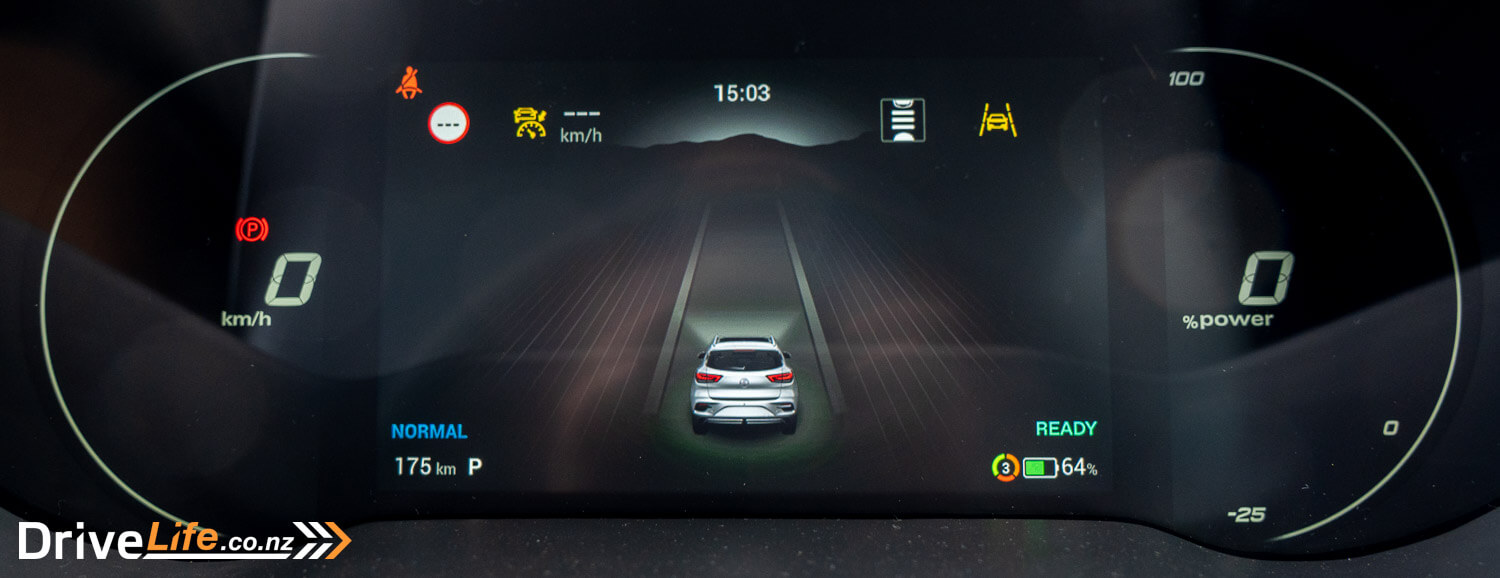
Yes, yes – there will be people sitting there reading this and saying I had to sit around for a total of 108 minutes waiting for the car to charge. Honestly, big deal. I went for a walk, got coffee, and worked on the laptop. It’s far safer to take regular breaks on a long trip than try and do it in one hit. And I saved money, so I’m fine with the wait time.
On getting home, I plugged the car in that night. Charging up at home is always cheaper. But I did notice that while MG has introduced a charging indicator by the charge port, there’s no light there so you can see where you are plugging in at night. Hopefully, we’ll see this on the next model update.
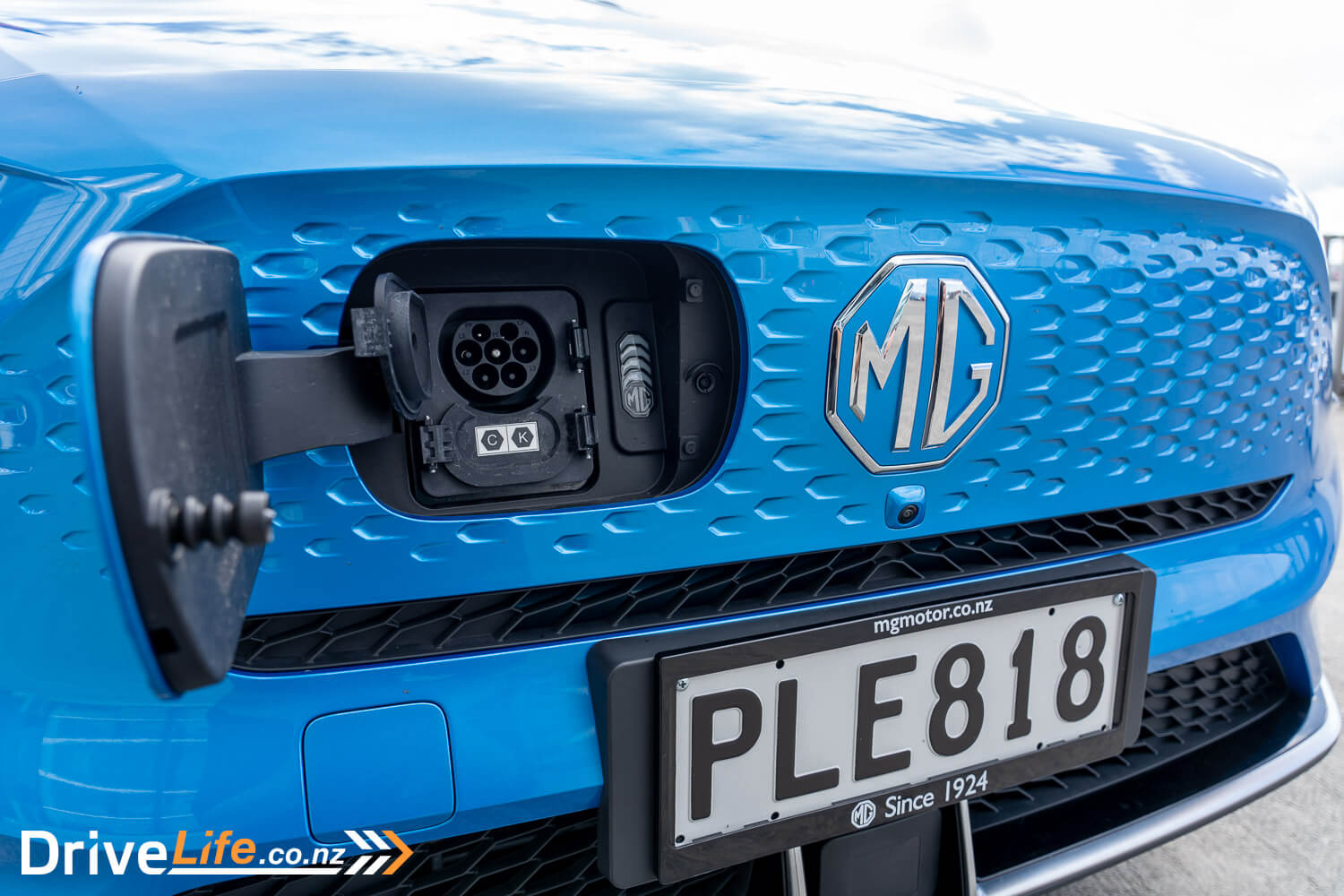
One feature that’s currently unique to MG and Hyundai is Vehicle To Load (V2L) capability. Let’s say the power goes out at home, or you are camping and want to plug in some 230-volt household device. After buying the V2L adaptor and plugging it into the ZS EV, you can then plug in your household appliance and it will work. There are some limitations here; you can only plug in something that draws no more than 2,400 watts of power, but honestly, that’s a lot. Laptops and the like will be a breeze to charge up, and it simply draws stored energy from your ZS EV’s battery bank to power the device/s. It’s a great idea. At the moment, MG doesn’t have a cost for the V2L adaptor.
After 900Km of use, our MG ZS EV Essence returned 19.0kWh/100Km. How does that compare with others? When Alistair reviewed the Hyundai Ioniq 5 recently, he got 16.8kWh/100Km out of it, and the Lexus UX300e I reviewed did 19.5kWh/100Km. So it’s ballpark with other EVs.
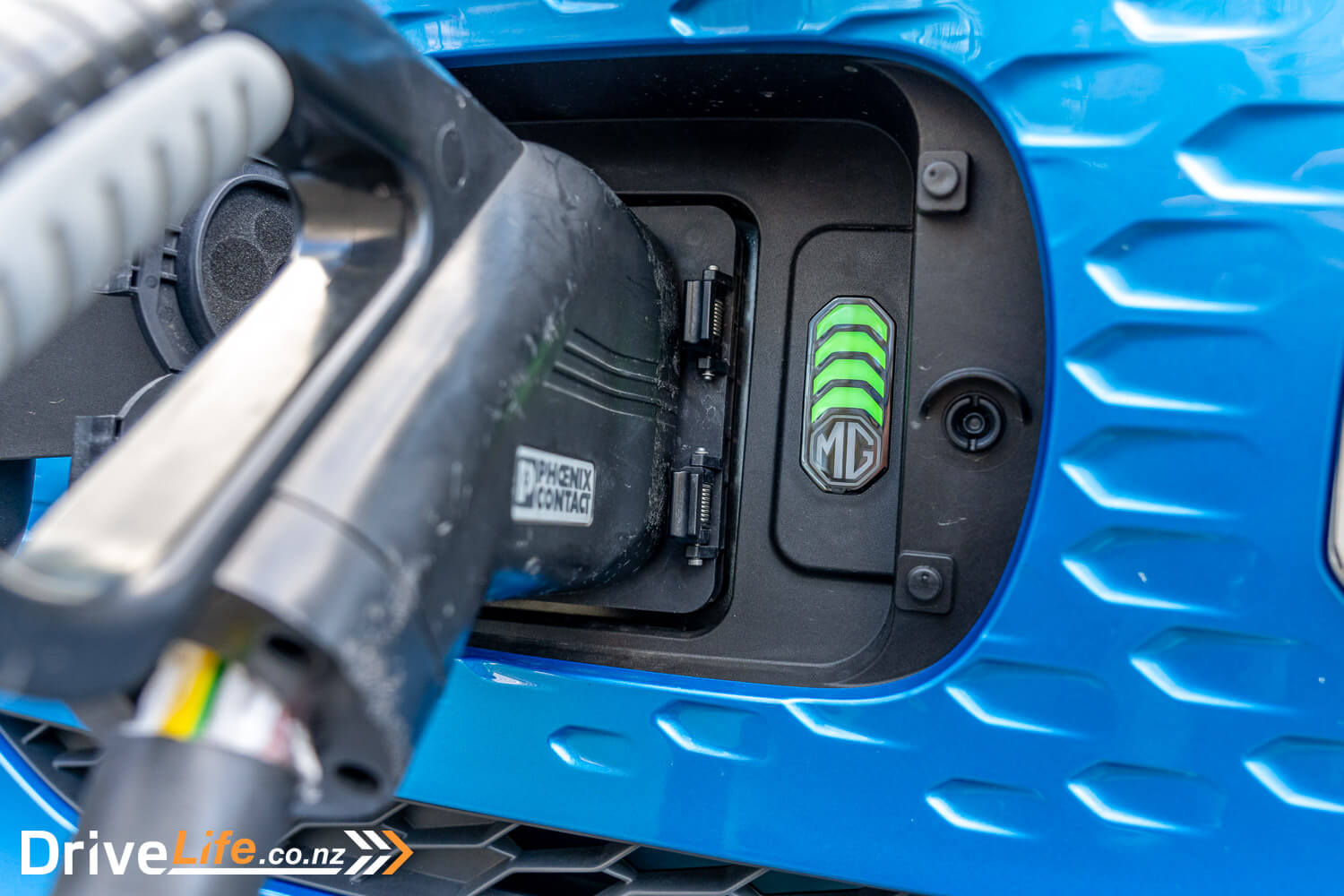
[ROB’S POINT OF VIEW]
I reviewed the previous ZS EV and said although it was good, I would find the extra cash to buy the Mazda MX-30 instead. Well, you know what? After driving this one, I’d buy the MG over the more expensive car – and I’d definitely have one over a Tesla Model 3.
The interior quality is very good and worthy of a more expensive car. Everything is where you expect it to be, everything works just fine. For the average car user who isn’t doing long trips every week, this would likely be the perfect car. It’s quiet, it’s quick enough, and it’s easy to drive and live with.
It’s not an enthusiast car by any means, it’s a transport device, and it fills that brief perfectly. Add to that its seven-year warranty, and the clean car rebate taking the price down to the level of lots of petrol cars and it’s hard not to recommend. Go and drive one, I think you’ll be impressed.
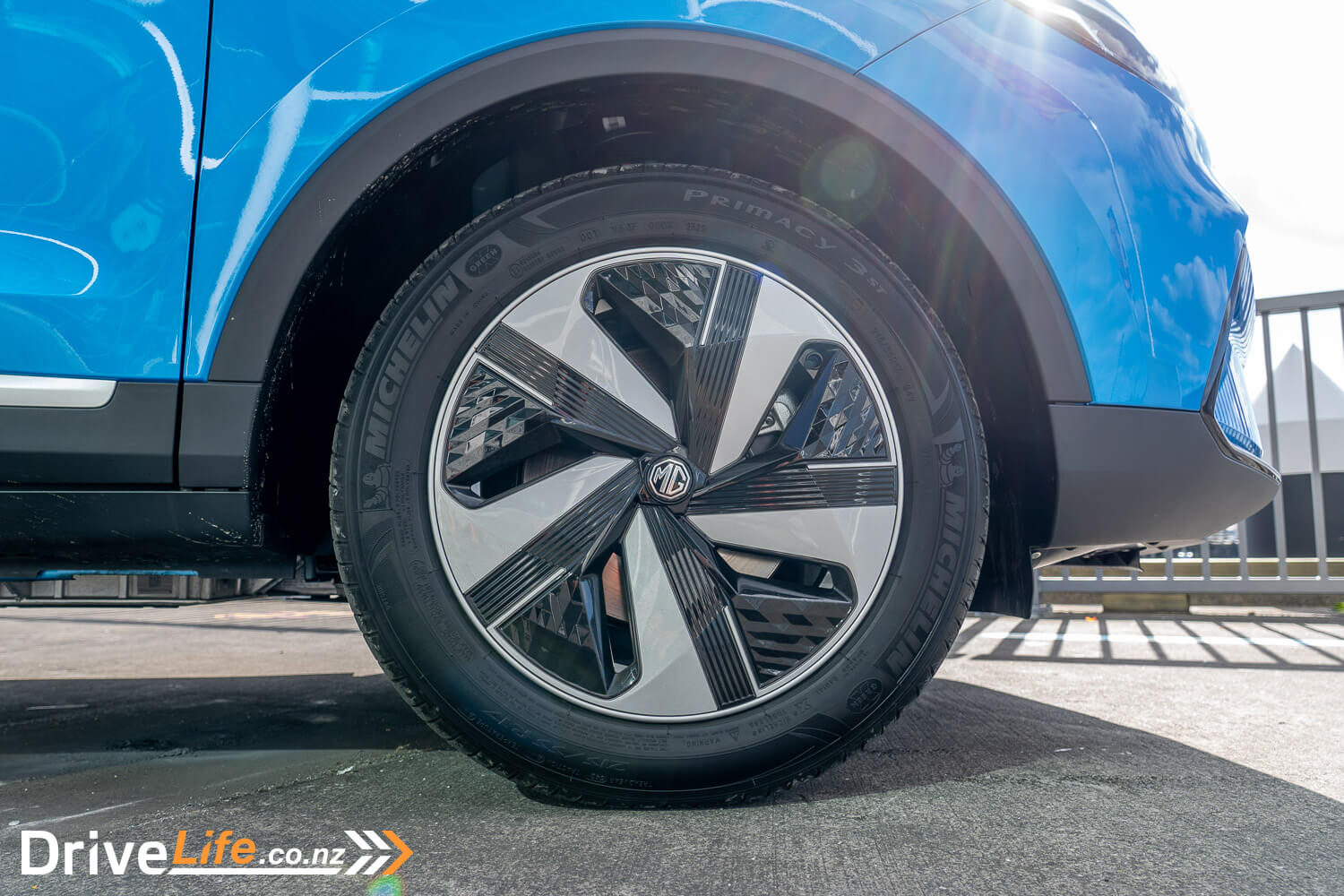
[ALISTAIR’S POINT OF VIEW]
Unlike what our Instagram feed might suggest, most of our lives are spent performing mundane tasks. Taking the kids to school, commuting to work and driving to the supermarket are hardly worthy of the ‘gram, unless you’re doing it in say, a Rolls Royce.
For the rest of us that live on planet earth, many just want a car that’ll do the chores. It’s even better if it happens to be electric, because that’s what all the noise is about these days.
This is where the MG ZS EV steps in. It’s a crossover, it’s cheap and it’s electric. It’s also about as exciting as a bar of soap.
That said, it ticks many boxes. It’s practical, it’s well-equipped, rides reasonably, and it’ll do 300-and-change kilometres on a single charge. The build quality is also good, which is a testament to how far Chinese cars have come in the past 5 years.
This being the second-generation ZS, it corrects many of the undercooked aspects of the first car. The new car gains a much-needed upgrade to the infotainment system, and the drive-mode and regenerative braking switches are much more responsive. The exterior has been tarted up, and the interior has seen some modification too. Though, there are still some oddities, like the steering is unusually heavy for a crossover. The turning circle isn’t great either.
As a pure utility, I’ll admit that the MG ZS EV is a compelling offering. For the 90% of life that’s routine, the MG ZS EV will fit in just comfortably. It did exactly that for me.
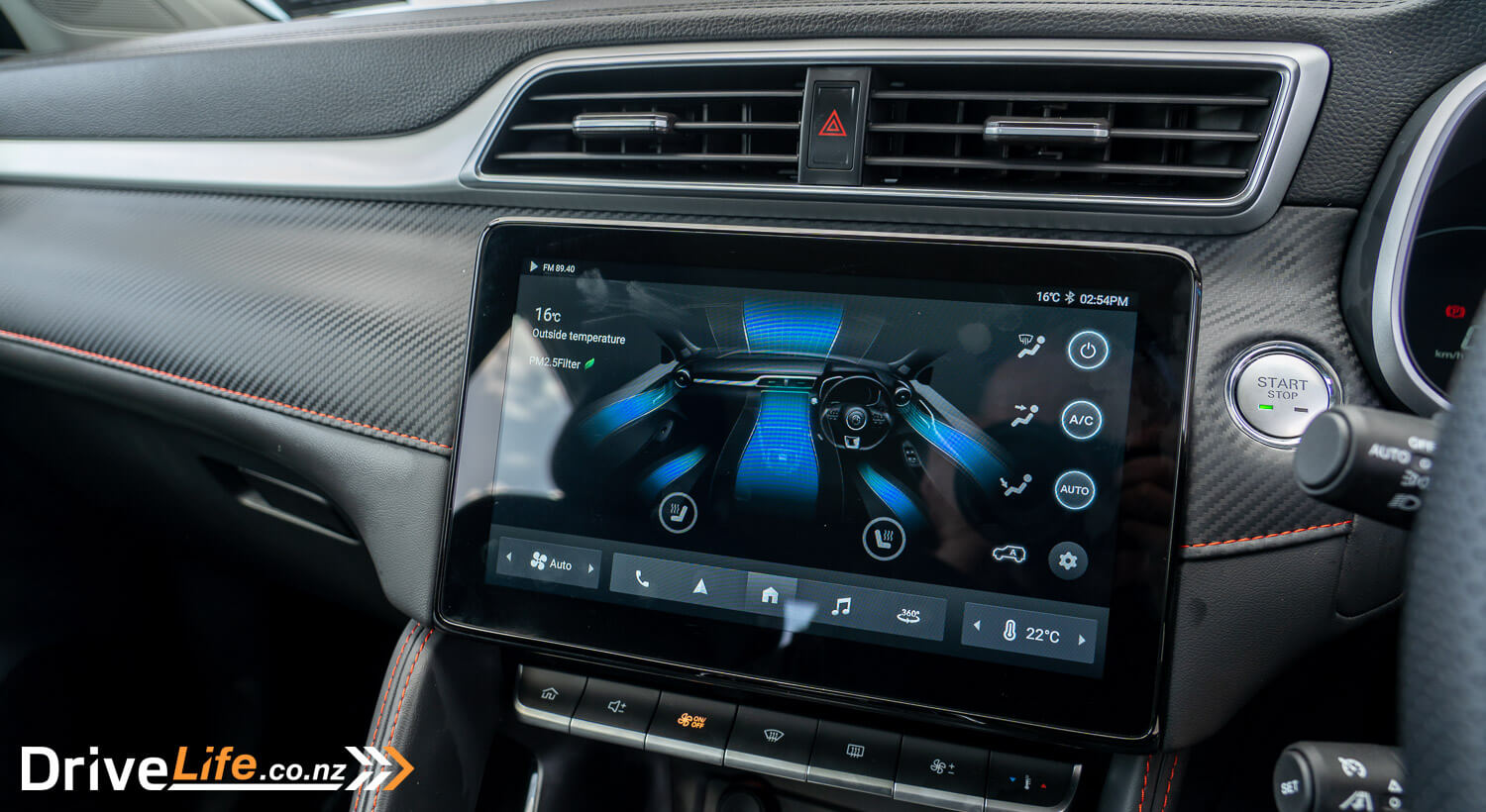
2022 MG ZS EV Essence – Specifications
| Vehicle Type | 5-door, front-wheel drive, small electric SUV |
| Starting Price | $53,490 |
| Price as Tested | $54,115 |
| Engine | Single electric motor |
| Power, Torque kW/Nm | 130/280 |
| Spare Wheel | Pump only |
| Kerb Weight, Kg | 1,610 |
| Length x Width x Height mm | 4323x1809x1649 |
| Boot Space / Cargo Capacity, Litres (seats up/seats down) | 359/1,187 |
| Energy Economy, kWh/100km | Advertised Spec – Combined – 17.1 Real-World Test – Combined – 19.0 Low Usage: 6-10 / Medium Usage 11-19 / High Usage 19+ |
| Towing Capacity Kg, unbraked/braked | 500/500 |
| Turning circle metres | 11.2 Small: 6-10m / Medium 10-12m / Large 12m+ |
| Warranty | 7 years unlimited Kms vehicle warranty 7 years battery warranty 7 years Roadside Assist 7 years Wof checks |
| Safety information | ANCAP Rating – 5 stars (2019 model) – Link Rightcar.govt.nz – 5 Stars – PLE818 |
Have you enjoyed this review? Be sure to join our monthly email newsletter list so you don’t miss a single car review!


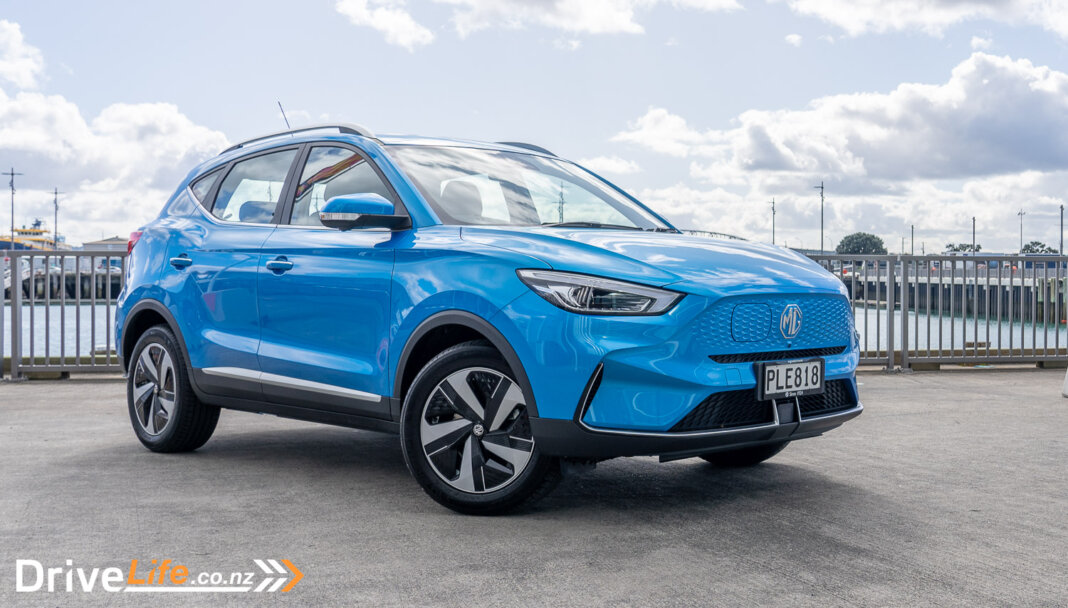






Hi,
Your calculations for fuel cost are incorrect. The standard petrol model for 652kms distance at 7.1L/100km at $2.84 = $131.47.
This will compare favourably with the EV *when* RUCs of $76/100km are factored in. $76 * 0.652 = $49.55. Total $75 + 49.55 = $124.55 for the EV.
Thanks.
Hi Matthew. Thanks for the comment, and of course you are right! I checked those numbers twice, believe it or not, and still got them wrong. Thanks heaps, and I will amend the article.